CAN WE REVERSE CELL AGING?
ESCAPE THESE THOUGHT TRAPS
CHANNELING THE POWER OF ADDICTION
POSITIVE THAT YOU'RE I'M NEGATIVE
HOT FLASHES IN THE HOT ZONE
JASON PATTON
WHERE THERE’S A LAUGH, THERE’S A WAY

THE CARNIVORE DIET MEATY DECISIONS
SPRING 2023 OVERSHARING AT THE FIREHOUSE? TMI?
WE NEED HMB & VITAMIN
DO
D3?
First responders enjoy 20% off sitewide, year round DEVIL-DOG.COM

FOCUSED ON COMFORT & DURABILITY SINCE 1948




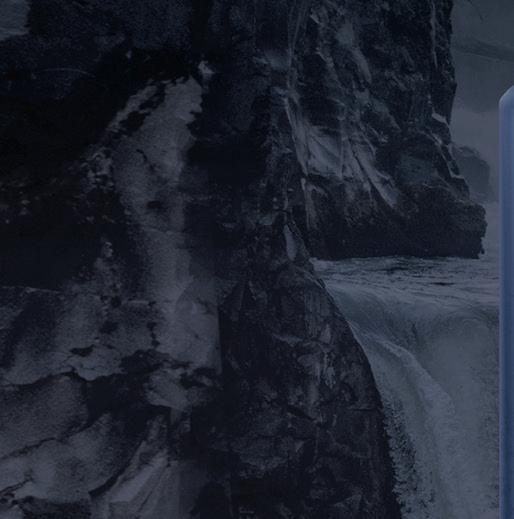





WE CAN’T THANK YOU ENOUGH.

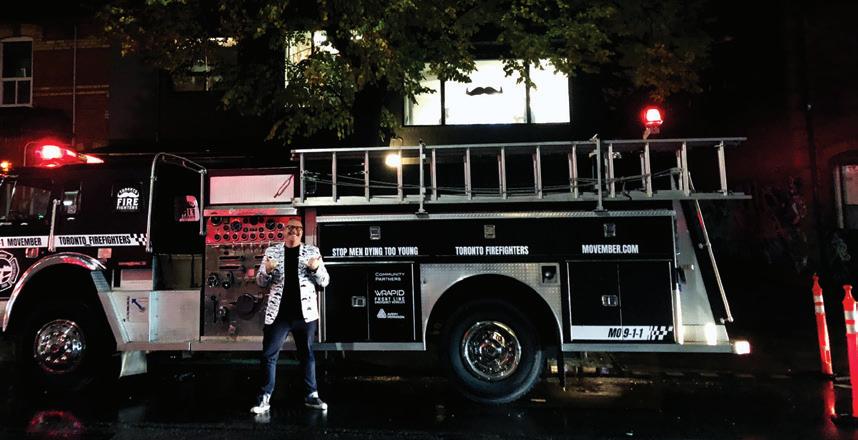
We’re inspired by your commitment to the community. Your support of Movember is more than we could’ve asked for –and has blown us away.

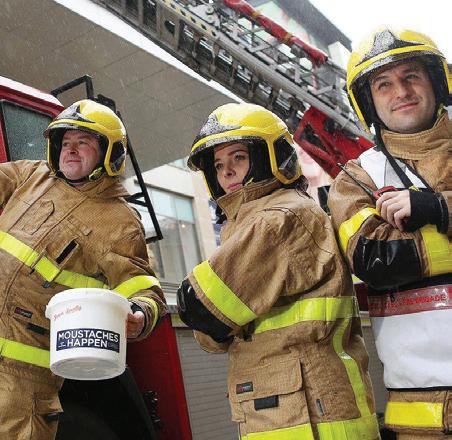
And even though moustache season is over, let’s make mental health a bigger part of the dayto-day. We’re here to help. It’s the least we can do to show how much we appreciate you.

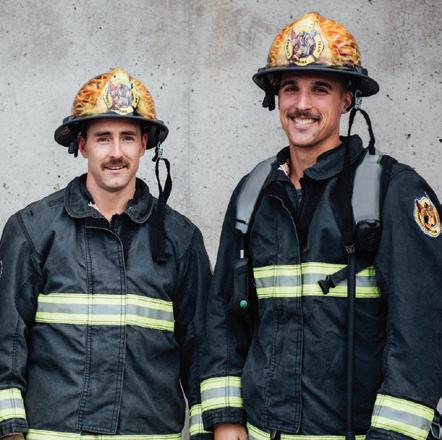

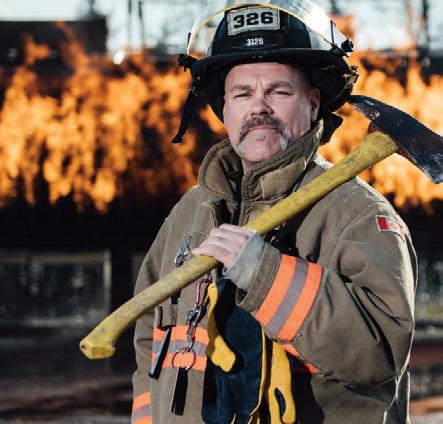

FEATURED in this issue
40
CAN WE REVERSE CELL AGING?

80
POWER OF ADDICTION
MEATY DECISIONS: WHAT IS THE CARNIVORE DIET?

A LAUGH, THERE’S A WAY
JASON

PATTON: WHERE THERE’S
HARNESSING THE MONEY DRAGON

HOT FLASHES IN THE HOT ZONE
AT THE FIREHOUSE

16 23
CHANNELING THE 34
50 52
THE BENEFITS OF OVERSHARING
CONTENTS 12 I’M POSITIVE THAT YOU’RE NEGATIVE Health 14 CHASING HUMILITY Relationships 16 CAN WE REVERSE CELL AGING? Health 18 DO WE NEED HMB AND VITAMIN D3? Fitness 23 CHANNELING THE POWER OF ADDICTION Stress 28 ESCAPE THESE THOUGHT TRAPS Stress 32 SIMPLE TOOLS FOR YOUR FIRE STATION GYM: THE MED BALL Fitness 34 MEATY DECISIONS: WHAT IS THE CARNIVORE DIET? Health 40 JASON PATTON: WHERE THERE’S A LAUGH, THERE’S A WAY Lifestyle 46 WHY CASUAL SEX IS DESTROYING YOUR RELATIONSHIPS Relationships 48 THE SPIRITUAL LIFE OF A FIRST RESPONDER Health 50 HARNESSING THE MONEY DRAGON Finance 52 HOT FLASHES IN THE HOT ZONE Health 56 EAT TO THRIVE TOGETHER Health 63 JAKEBREAK Comic 64 SAIL INTO ADVENTURE! Lifestyle 69 MIXING ALCOHOL AND FIREFIGHTING IS A DEADLY COCKTAIL Health 72 THE ART OF THE FART 74 ARE YOU READY FOR THE FIREGROUND? Fitness 80 THE BENEFITS OF OVERSHARING AT THE FIREHOUSE Relationships 84 DOC ON DUTY Health 88 TANGY MEDITERRANEAN CHICKEN Recipe
A LETTER FROM THE PUBLISHER

The future is elusive – always just a step ahead and drawing us forward. I’m always thinking about how far we’ve all come in the firefighting profession—but also, how far we still need to go.
Meeting other firefighters in the fire service is a constant reminder of how uniquely different we all are because our personalities and experiences are as varied as any group I can imagine. The fire service itself isn’t just made of brick and mortar fire stations with red fire trucks – it’s a dynamic blend of incredible individuals who give their best days in the service of others. It’s something I’m proud to be a part of, and I encourage you to get out and meet others who do what we do so you can share that pride. Attend a trade show or wellness event at least once a year and connect with other firefighters to share stories, thoughts, ideas and experiences. There’s an old saying that if you want to go far, don’t go alone. I agree…and I’d add, “If you don’t want to burn out, don’t sit out!”
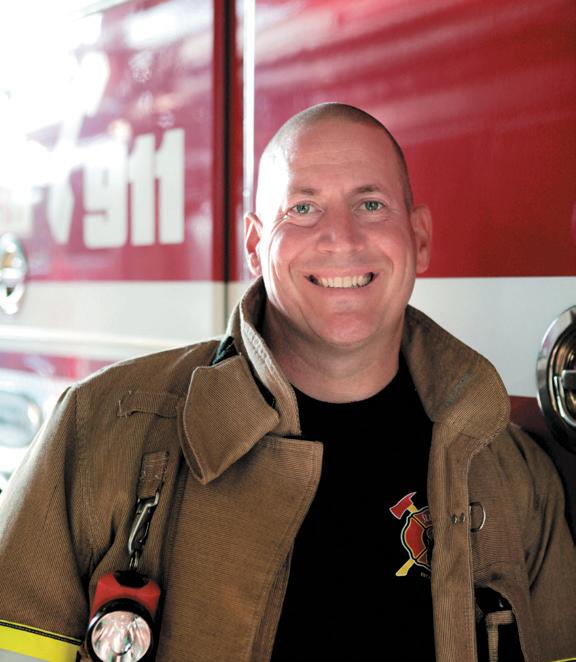
In this issue we put some focus on addiction, and on helping to understand addictive behaviors. Instead of hiding from them, we should harness our knowledge to help understand and retool them into strengths. Changing perspective could change your outcome.
“The past is a place of reference, not a place of residence; the past is a place of learning, not a place of living.” – Roy T. Bennett
Enjoy!
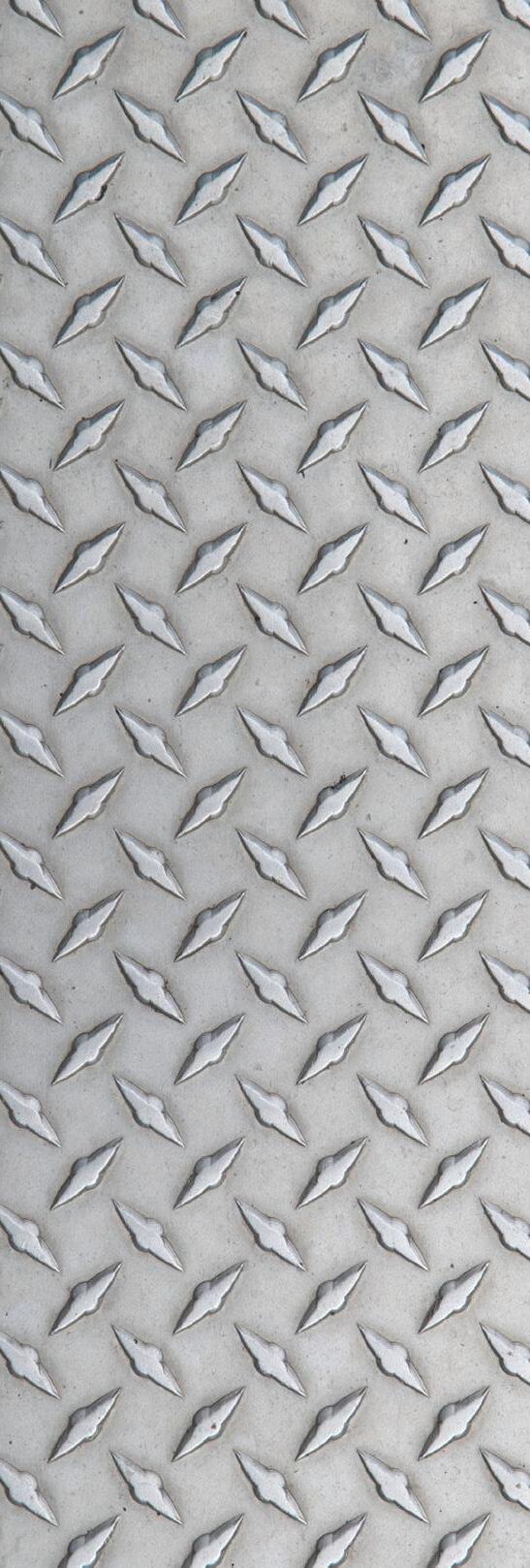
The National Alliance on Mental Illness (NAMI) is the United States’ largest grassroots mental health organization dedicated to improving the lives of individuals and families affected by mental illness. NAMI Frontline Wellness is an initiative designed to support the mental health of public safety and health care professionals.
The effect of cumulative stress, trauma, moral injury, and shift work can have a significant impact on mental and physical health. As a result, frontline professionals experience high rates of mental and physical health conditions – but it remains difficult for them to reach out for support.
NAMI Frontline Wellness provides information and no cost, confidential resources via nami. org/frontlinewellness, as well as education and support throughout our network of 49 NAMI State Organizations and more than 670 local affiliates across the country. Resources include professional and peer support options, resilience and wellness tools, substance abuse information, and resources and support for family members, agencies, and organizations.

WHY THE NAME CRACKYL?
The inspiration behind the name CRACKYL comes from a feeling firefighters experience in the middle of a structure fire when a sudden calm comes over you and you hear a fire crackling all around a smoke-filled room, but can’t see it. The sound of a fire crackling is imprinted on every firefighter’s mind, and it roots us in this exhilarating and unpredictable profession. We want CRACKYL to become a sounding board for firefighters throughout their careers.
Firefighters are notorious for sitting around the firehouse, discussing their problems and offering advice. But the truth is, many of us don’t have the answers. We don’t know why we all fight about the same problems with our partners, never seem to have enough money left at the end of the month and just can’t get along with the co-workers who are the most like us. At CRACKYL, we want to be the firefighter in the station who has a lot of those answers and provides accurate, practical, and life-changing solutions to the problems we all face.
PUBLISHER Kory
Pearn
EDITORIAL
PUBLISHER / CEO KORY PEARN KPEARN@CRACKYLBUSINESSMEDIA.COM
EDITOR-IN-CHIEF LIZ FLEMING
DIGITAL EDITOR LEAH SOBON
COPY EDITOR MARTHA CHAPMAN
EDITOR@CRACKYLBUSINESSMEDIA.COM
DESIGN
EDITORIAL DESIGNER SARAH ROSS
EDITORIAL DESIGNER NICOLE MANNELL
BUSINESS DEVELOPMENT
DIRECTOR OF BUSINESS DEVELOPMENT


DYLAN LABELLE DLABELLE@CRACKYLBUSINESSMEDIA.COM
SALES
PUBLISHER / CEO
KORY PEARN KPEARN@CRACKYLBUSINESSMEDIA.COM

ACCOUNT & SOCIAL MEDIA MANAGER
MARIA PELLETIER MPELLETIER@CRACKYLBUSINESSMEDIA.COM

PARTNERSHIPS
PARTNERSHIP MANAGER
MATT RUMAS MRUMAS@CRACKYLBUSINESSMEDIA.COM
CONTRIBUTORS
ELIZABETH ANDERSON. MARTHA CHAPMAN, HOWARD A. COHEN, DANIELLE COOK, ERIN S. CRAW, CARRIE FLEETWOOD, LIZ FLEMING, GREGORY GORDONSON, NICK HALMASY, HUSSIEN JABAI, JOSOPH KOZIKOWSKI, VIRGINIA LOEWENSTINE, JOHN MACKENZIE, RICK MARKLEY, SIMON MATTHEWS, ELIZABETH MCKISSICK, ANASTASIA MILLER, RYAN PROVENCHER, LEAH SOBON, ALWYN WONG COMIC
CARTOONIST JEFF MAKSUTA
CRACKYL Magazine is published four times a year by CRACKYL Media Inc. with copies delivered to firefighters across North America and beyond. No part of the content, including but not limited to editorial, advertising or photography, may be copied or reprinted without the permission of the publisher. ISSN # 2563-612X
PUBLISHED AND PRODUCED BY: CRACKYL MEDIA INC.
SUBSCRIPTIONS
ORDER A ONE-YEAR ($32.89 USD) BY VISITING: CRACKYL.COM/MAGAZINE
FIRE DEPARTMENTS SAVE 40% ON PRINT SUBSCRIPTIONS.
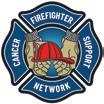
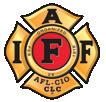

TO ORDER MULTIPLE SUBSCRIPTIONS CONTACT: INFO@CRACKYLBUSINESSMEDIA.COM
SIGN UP FOR A DIGITAL SUBSCRIPTION CRACKYL.COM
The opinions presented in our magazine are those of the authors of the articles. We enjoy the opportunity to present a variety of viewpoints but do not necessarily endorse them.
ON THE COVER: JASON PATTON
PHOTO BY: CATALYST DESIGN AND PHOTOGRAPHY
CRACKYL EXPERTS
EMERGENCY MEDICINE
MICHAEL GUIRGUIS, M.D. BEN TANNER, EMERGENCY MEDICINE PA
EXERCISE SCIENCE
ANTHONY DE BENEDICTIS, CAT(C), CSCS TODD CAMBIO, BS, BA, CSCS BRITTANY S. HOLLERBACH, PH.D.
JIM MCDONALD, NSCA, CPT, CSCS, TSAC-F
HUSSIEN JABAI, MS, CSCS, TSAC-F, CPT
JOE KOZIKOWSKI, NSCA-TSAC-F, PN2, PPSC
FINANCE
TRISH VAN SICKLE, LLQP, CSC MATTHEW BROOM, BBA, CFP
INTEGRATIVE HEALTH
NOAH GENTNER, PH.D., NBC-HWC
MENTAL HEALTH
ASHWIN PATEL, PH.D
ANASTASIA MILLER, PH.D.
SARA A. JAHNKE, PH.D.
SIMON MATTHEWS, FASLM DIPLLBLM, MHLTH SC, NBC-HWC, ICF-PCC
NUTRITION
MAUREEN STOECKLEIN, RD
MEGAN LAUTZ, MS, RD, TSAC-F
PATRICK MCCARTHY, MS
SEX & RELATIONSHIPS
CARRIE FLEETWOOD, B.A., M.ED., R.P. O.A.M.H.P.
DERMATOLOGY
SANOBER PEZAD DOCTOR, PH.D
SLEEP HEALTH
BEVERLY DAVID, REGISTERED PSYCHOLOGIST PH.D., CLIN.PSY.D, CLIN.PSYCH
STRESS
WENDY LUND, BSCN, MSC
DONNIE HUTCHINSON, MBA, PHD TINA BONNETT, ED.D, M.ECED., R.E.C.E., CERTIFIED TRAUMA INTEGRATION CLINICIAN
TRAINING
JOHN HOFMAN, CSCS-D, TSAC-F D, MS HUSSIEN JABAI, MS, CSCS JAKE PATTEN, SCCC, TSAC-F, USAW, PN-1 AARON ZAMZOW, BS-HEALTH AND WELLNESS, NSCA-CSCS, NASM-CPT, ACE-PEER FITNESS, PN1 DAVID VAUX, MSC
WELLNESS
DANIELLE COOK KAWASH, MS, RD, NBC-HWC ALWYN WONG, BSC, DC, ART, MED. AC.
THANK YOU TO OUR PARTNERS
@CRACKYLMAG
24 Hour Continuous-EKG
Strain Monitoring
Heart Rate Variability
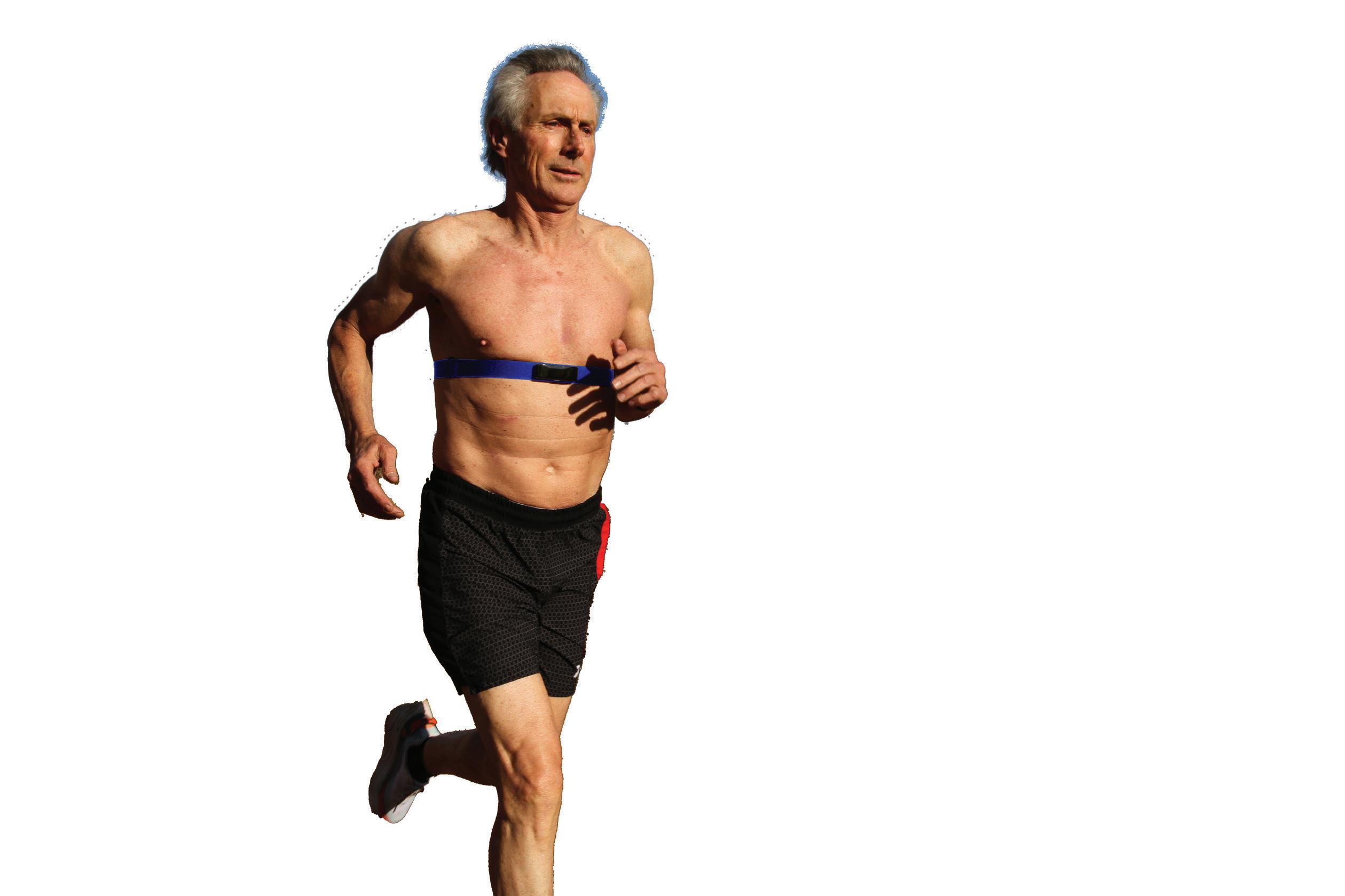
Heart Rate
Six-times Ironman World Champion
Use code CRACKYL20
to get 20% off your Frontier X2
Mark Allen



’m Positive That
How do you fight negativity among coworkers – and why is that negativity so contagious?
Negativity can show up in all corners of any workplace. It can be directed to officers from firefighters, to firefighters from officers, or between firefighters… and between officers.
Maybe you feel you don’t get enough recognition for your efforts. Maybe you're frustrated that your co-worker isn’t pulling his or her weight at the station. Or you're flabbergasted that you didn’t get that promotion despite being next in line.
At best, these kinds of thoughts are a distraction from the purpose and mission of the firehouse, but at worst they can grow, spread and create a toxic work environment that has serious implications for everyone’s health and safety.
Robert Sutton, PhD, offers valuable insight on the topic of workplace negativity in his book titled “The No Asshole Rule – Building a Civilized Workplace and Surviving One That Isn't” which should be required reading for anyone setting foot in a firehouse. In it, Sutton equates negativity with being an asshole –and many would agree that’s a reasonable claim.
The first question is: What exactly do we mean by “negativity”, and how do we know it when we see it?
In assessing the negativity Sutton provides two tests. First, he says you can tell if someone is an asshole if after talking to them, you feel "oppressed, humiliated, de-energized,
or belittled”. In essence, if you feel generally worse about yourself after an interaction, you might be dealing with an asshole.
The second test involves how people treat others. If someone treats less powerful people poorly, they might be an asshole. Sutton is careful, however, to distinguish between people who might be having a bad day and those "certified assholes" whose poor behavior is consistent over time.
And what exactly is “poor behavior”? Again, Sutton provides a useful answer in what he calls the Dirty Dozen, a list of behaviors he considers common to assholes and which contribute to a negative, toxic workplace environment.
i
" GOOD NEWS TRAVELS FAST, BUT THROUGH THE WALLS OF A FIREHOUSE BAD NEWS TRAVELS AT THE SPEED OF LIGHT.”
HEALTH
12 | CRACKYL MAGAZINE
By John MacKenzie
You’re Negative
These include: personal insults; invading someone else’s personal territory; uninvited physical contact; threats and intimidation, both verbal and nonverbal; sarcastic jokes and teasing used to deliver insults; withering emails; status slaps on social media intended to humiliate the victim; public shaming or status degradation rituals; rude interruptions; two-faced attacks; dirty looks; and treating people as if they are invisible.
WHAT ABOUT YOUR WORKPLACE?
Now, think of your own workplace. Really think. Is it possible you have one or two assholes kicking around?
If so, it's not all bad, Sutton insists. Steve Jobs of Apple was notoriously difficult but went on to lead a global technology empire. People who knew him suggested that he was one of the most imaginative, decisive, and persuasive people they'd ever met. Sutton suggests that it's naïve to assume that assholes always do more harm than good. Sometimes they can bring out qualities in people that
wouldn't have been apparent otherwise. But, this of course, doesn't mean anyone should have to put up with it.
So, how do we deal with the firehouse assholes we encounter – and avoid becoming one?
Sutton suggests useful strategies to avoid becoming a party to a negative workplace. A popular adage says that the best time to plant a tree was 20 years ago, but the secondbest time is now. In the context of this topic, it's best to assess potential workplaces for the concentration of assholes in their ranks. Too full? Consider keeping your distance. Failing that, the next best thing is to leave a toxic workplace as soon as possible or, if you can't leave, avoid toxic people whenever possible.
Further, although there is natural competition in workplaces, fostering a culture of commonality is very useful. Sutton puts it this way:
"Adopt a frame that turns your attention to ways in which you are no better or worse than other people. Don't focus on all the big and little ways that you are superior...or inferior. Think of all the
ways that fellow human beings are just like you, such as the needs that we all have for love, comfort, happiness, and respect." This seems like a powerful, simple way to defuse the flame of workplace negativity before it ignites.
ARE YOU THE PROBLEM?
Lastly, consider a critical evaluation of yourself. Are you a workplace asshole? Sutton suggests that admitting you're one is the first step. While it's cheeky advice, it should be carefully considered. How do others really perceive you? Is it possible you're contributing to a negative workplace for others? If so, it’s best to take steps to stop.
We all want the same thing, which is the purpose and mission of the fire service writ large: to help people in times of crisis and need. As firefighters, we have unique knowledge, skills and qualities that enable us to carry this out in particular ways.
Let’s not allow negativity to make us lose sight of the tasks, relationships, and experiences that lie before us. Remember: if you’ve evaluated everyone around you and still haven’t solved your workplace negativity problem, it’s likely time to swallow that pride and look inward.
IF YOU FEEL GENERALLY WORSE ABOUT YOURSELF AFTER AN INTERACTION, YOU MIGHT BE DEALING WITH AN ASSHOLE.
xSPRING 2023 | 13
So…how’s your self-esteem? Feeling pretty confident about yourself —or is there a niggling hint of self-doubt that creeps in from time to time?
WHILE IT’S PERFECTLY NORMAL –AND REFRESHINGLY HUMAN – TO HAVE MOMENTS WHEN WE FEEL LESS THAN COMPLETELY CONFIDENT, LONG STRETCHES OF SELF-DOUBT CAN SIGNAL SELF-ESTEEM PROBLEMS.
And statistics show that low selfesteem is one of the issues most often uncovered when we seek counseling.
Many of us find it hard to admit to our self-doubt, think it’s a shameful emotion, and instead, try to hide behind shows of false bravado. Sometimes, those shows can be pricey.
We buy bigger vehicles and spend more than we can afford to make our
Humility Chasing
By Elizabeth Anderson
homes the envy of the neighborhood – and we take pride in our possessions. But there are different forms of pride: some good and some much less so. Pride can be a defence mechanism (a usually unconscious method to cope with stress or anxiety) when we’re wrestling with low self-esteem.
Many psychologists divide pride into two types: authentic (good) and hubristic (bad).
HUBRISTIC PRIDE – WHICH SOME PEOPLE THINK OF AS EGO – IS ARROGANT, BOASTFUL, AND NARCISSISTIC, A FALSE FRONT DESIGNED TO IMPRESS OTHERS AND PROP UP OUR SAGGING SELF-ESTEEM.
AUTHENTIC PRIDE, ON THE OTHER HAND, IS THE RESULT OF POSITIVE FEELINGS ARISING FROM A LEGITIMATE ACCOMPLISHMENT.
Hubristic pride rears its head when the mind tries to assuage negative feelings we may have about ourselves. Rather than relying on the self-validation that comes from a positive self-image, we turn to others and often go to great lengths to earn their admiration. We lie, spend money we can’t afford and make a world of bad decisions. It’s dysfunctional behavior that brings out the ugliest parts of us.
Biblical scholars will tell you that pride of the hubristic variety is one of the Seven Deadly Sins, and is often referred to as the one from which all others arise. Hubristic pride can lead us to project a fabricated positive persona while at the same time we criticize and nit-pick to everyone around us. Often we aren’t aware of what we’re doing, or why.
RELATIONSHIPS
14 | CRACKYL MAGAZINE
THE PROBLEM IS THIS: WE AREN’T ONLY TRYING TO IMPRESS OTHERS, WE’RE ALSO TRYING TO CONVINCE OURSELVES AND WE MAY RESPOND AGGRESSIVELY TO THE SLIGHTEST AFFRONT.
We’re angry and resentful when other people don’t validate us the way we want them to. We lie and exaggerate our own accomplishments and can become consumed with being right and unable to see when we’re wrong. We feel like victims of the world, denied the wealth and prosperity we think we deserve, focusing on what we don’t have, rather than being grateful for what we do. We burn with envy at those who have more.
It’s a recipe for a dark and unhappy psyche and a behavioural pattern that makes it very difficult for others to like us.
There’s a fine line that divides the two types of pride. Firefighters, for example, have a lot to be genuinely proud of, and deserve praise and thanks for their selfless work and for risking their own lives to save others. It’s only reasonable to take authentic pride in your firefighting career, and to use this healthy pride as a motivator. It should create a healthy sense of self-esteem. But boasting about your work in an effort to impress others and feeling anger when they don’t respond with the admiration you expect amounts to hubristic pride, and may represent an effort to compensate for low self-esteem.
This constant worry about what others might think can be exhausting and some of us take the effort to extremes. We may become sexually promiscuous and manipulative, we may enter into relationships that are unhealthy and
need constant validation from our partner. Relationships come and go quickly, but we can’t stand being alone, so we’re forever trying to find the next lover.
In extreme cases, we may begin to delight in other people’s misfortunes and might even try to sabotage friends, feeling that if someone else is knocked down a peg, all the times we’ve been frustrated won’t seem so terrible. When self-esteem is at a low ebb, things can feel pretty dark and dysfunctional. We’re constantly scheming, looking for other people’s weaknesses and failings, and fretting about what other people think of us. We’re struggling to maintain appearances, many of which are false or exaggerated.
The great irony is that it’s so much easier to let go of the pretenses and just be ourselves.
RESEARCH HAS SHOWN THAT WHEN WE’RE COMFORTABLE IN OUR OWN SKIN AND HAVE A HEALTHY SENSE OF SELF-ESTEEM, PEOPLE LIKE AND RESPECT US MORE.
People are not only unimpressed by aggressive braggarts, they’re actually repelled.
Authentic pride is associated with healthy self-esteem – something for which we should all strive.
HERE’S A SURPRISING FACT: THE KEY TO HEALTHY SELF-ESTEEM IS ACTUALLY HUMILITY.
Wait, what? Humility? There’s a mistaken belief, widely held in Western society, that humility is something to be avoided and is, in fact, a sign of weakness.
“OH LORD, IT’S HARD TO BE HUMBLE, WHEN YOU’RE PERFECT IN EVERY WAY.
I CAN’T WAIT TO LOOK IN THE MIRROR, ‘CAUSE I GET BETTER LOOKIN’ EACH DAY.
TO KNOW ME IS TO LOVE ME.
I MUST BE A HELL OF A MAN.
OH LORD, IT’S HARD TO BE HUMBLE, BUT I’M DOING THE BEST THAT I CAN.”
MAC DAVIS
Many people believe that humility involves self-degradation. Not so.
Humility doesn’t mean that we abase ourselves or become anyone’s doormat. Billionaire Warren Buffett – the third richest man in the world – is well known for his humility. He definitely doesn’t belittle himself or diminish his accomplishments. He’s not meek, and he sure doesn’t have a low opinion of himself. He understands and is justifiably proud of his achievements and so naturally commands admiration and respect. Despite that, he lives a down-to-earth lifestyle, refusing the luxuries he can so easily afford.
Humility is a highly desirable character trait, associated with prosocial behavior, academic excellence, and better job performance. Humility has been shown to be a powerful tool in helping us to handle life’s inevitable hardships by providing psychological resilience.
It is, quite simply, unvarnished, positive self-esteem that doesn’t depend upon validation from others. Humility is a realistic appreciation of one’s limitations as well as one’s strengths. It fosters a healthy self-esteem built on an unshakeable understanding of our own self-worth, devoid of the need to maintain a false front to show the outside world. Humility is not about needing to prop up our feelings of self-worth by impressing others through our material worth or demonstrations of grandeur.
AS THE MONK, SCHOLAR AND SOCIAL ACTIVIST THOMAS MERTON SAID: “IT’S HUMILITY THAT MAKES US REAL.”
SPRING 2023 | 15
CAN WE REVERSE CELL AGING?
By Dr. Alwyn Wong
Despite our best efforts, our pursuit of optimal health often falls short. And that only increases with age.
With the passage of time, the number and types of stressors in all our lives increase. Stress comes in many forms – physical, emotional, financial, psychological – but the result is the same: a part of the brain known as the hypothalamus stimulates the pituitary gland to release a hormone called ACTH (adrenocorticotropic hormone) which then acts on the adrenal glands that sit on top of each kidney. This triggers the kidneys to release the hormone cortisol.
Too much cortisol can lead to cellular destruction called senescence. When cells become senescent or aged, they stop behaving as they were designed to. Regardless of what we call it, a hallmark feature of cellular destruction or senescence is the release of pro-inflammatory chemicals known as cytokines, proteases, and miRNAs. Stress-
HAEMOPOETIC STEM CELLS
induced senescence also causes both DNA damage and alteration, leading to chemicals that cause nearby cells to break down, resulting in a cascade of destruction and rapid aging.
Yikes! That’s a whole lot of scary science! So, how does the process of stress and aging make our fitness efforts futile? Problems arise when senescence affects muscle, nerve, and even fat cells that can lead to a disruption of function and an array of negative health effects and diseases.
But can the stress-senescence axis affect cells that have yet to become what they’re meant to be – our stem cells?
Let’s take one more dive into the scientific muck to discuss stem cells and progenitor cells.
Stem cells, the focus of much research over the last ten years, by contrast have the potential to develop or differentiate into various cell types, including muscle, nerve and fat cells,
among others. Stem cells hang out idly on the sidelines waiting to be put on the field or court. When called upon, these cells replace damaged cells and repair damaged tissues and organs, including muscles, nerves, and fat cells.
Progenitor cells are the next step in stem cell differentiation but they can only further develop into the cells that they’re designed to become. For example, a progenitor nerve cell can only become a fully functional nerve cell. These cells have to remain healthy in order for our body to recover from various stressors. And that’s the rub. In response to stress, cells including stem and progenitor cells are subject to harm. When these cells become damaged, aged or senescent, our bodies experience the negative effects.
A hallmark of senescence is inflammation, cell destruction, and the stimulation of nearby cells to break down. The outcome, common to all cell types, is the inability of a cell to divide properly, resulting in large and damaged cells.

INTESTINAL STEM CELLS
The rapid turnover of cells in our digestive tract is due to the high concentration of stem cells there. If those stem cells become senescent, the digestive tract’s ability to recover is impaired.
Luckily, while the stem cells responsible for making blood actually decline in number as we age, their collective production of blood cells does not. This is thanks to increased production by healthy, functional stem cells. Despite this, mild anemia is often found in the elderly when cells age.
SATELLITE CELLS
The population of muscle stem cells (“satellite cells”), is relatively small, despite the fact that they’re responsible for muscle growth and repair. In addition to reducing in number as we age, satellite cells tend to produce more fibrous tissue versus muscle tissue and it is this loss of satellite cell function, not actual muscle, that is likely responsible for reduced recovery and shrinking muscle size as we age.
HEALTH 16 | CRACKYL MAGAZINE
NERVE CELLS
Luckily for us, the satellite nerve cell decline is resistant to many stressors. In this way, brain and neurological function is maintained; however, when senescence does strike, numbers reduce rapidly, leading to impaired memory and learning – hence the cognitive defects commonly seen in older individuals.

FAT STEM CELLS
White fat (“adipose tissue”) found around our organs is susceptible to senescence thanks to its high concentration of cortisol receptors. These stem cells lose their ability to divide properly until they no longer divide at all and simply enlarge. Once they reach a certain size, breakdown results in inflammation and water retention.
SKIN STEM CELLS
Skin stem cells are divided into categories with some responsible for hair growth such as hair follicle stem cells, and melanocyte-producing stem cells. Hair follicle stem cells don’t decline in number as we age even though hair loss is so common. It’s the loss of function that is responsible. Unlike hair follicle stem cells, the number of melanocyte stem cells rapidly declines with age.
HOW CAN WE PUT THIS WHOLE PROCESS INTO REVERSE?
In lieu of connecting your arteries with that of someone younger, there are a few steps we can take to prevent stem cells from becoming senescent, and for eliminating those that have.
REDUCE OUR SENESCENCE BURDEN
Senescent cells must be eliminated in order to prevent the damage they do and to protect nearby cells. Research has shown that fasting for 18 to 24 hours induces autophagy, the process used to recycle old proteins, damaged cells, and abnormal components of cellular checkpoints. When our body enters a state of autophagy, damaged cells and components are eliminated.
Various foods can also stimulate autophagy. These include:
• Green tea
• Coffee
• Ginger
• Curcumin
• Omega 3 fatty acids
• Berries
PREVENT OUR CELLS FROM BECOMING SENESCENT
Sympathetic or fight-or-flight dominance brought on by stress causes the release of cortisol from the adrenal glands. Excessive or prolonged exposure to cortisol will lead to the breakdown of cells and their components, but we can counter this by entering a state of rest-anddigest (“parasympathetic dominance”).
Try these techniques:
• Resonant frequency breathing (six breaths per minute)
• Avoid loud music
• Inhale lavender oil through a diffuser
• Walk in nature
• Take a panoramic view of artwork
• No more than three servings per day of processed foods
EXERCISE MORE
In addition to putting our body into a state of rest-and-digest, we can increase our capacity to deal with stress before the negative effects kick in. Moderate exercise for 150 minutes a week or intense exercise for 75 minutes a week will help.
SPRING 2023 | 17
D3? HMB DO WE NEED AND VITAMIN
By Fire Science Nutrition
Vitamin HMB (Beta-Hydroxy Beta-Methylbutyrate) and Vitamin D3 are two important micronutrients that are essential for the maintenance of muscle mass, bone density, and overall physical fitness and well-being of firefighters. Since you’re a part of this special group of people who face physical and psychological stress on a daily basis, adequate levels of these vitamins can help support your overall health and performance.

FITNESS
18 | CRACKYL MAGAZINE
HMB
Vitamin HMB is a naturally-occurring substance produced in the body when an amino acid called Leucine is broken down. Leucine has been shown to play a key role in muscle growth and recovery, as well as reducing muscle damage and inflammation – all of which are important for firefighters who are at high risk of muscle damage and muscle loss because of the physically-demanding nature of their job. A study conducted on firefighters found that those who supplemented with Vitamin HMB had significantly improved muscle mass, strength, and endurance compared to those who did not.
VITAMIN D3

Vitamin D3 is an important micronutrient involved in many physiological processes in the body, including fostering bone health, immune function, and muscle function. Firefighters are at high risk of Vitamin D deficiency because of the physicallydemanding nature of their job and the fact that they are often indoors for extended periods of time, away from sunlight, which is the primary source of Vitamin D. Vitamin D deficiency has been associated with a range of health problems including osteoporosis, muscle weakness, and an increased risk of falls and fractures.
A recent U.S. study conducted on firefighters found that those who took Vitamin D supplements had improved bone density and reduced risk of fractures from falls. Vitamin D has also been shown to improve muscle strength, function, and overall physical performance in firefighters, making it an important micronutrient for those who work in physically demanding jobs. In addition to the physical benefits of Vitamin HMB and Vitamin D3, there is evidence to suggest that these vitamins may also have psychological benefits. Vitamin D in particular has been shown to play a role in regulating mood and reducing the risk of depression. Firefighters are at high risk of mental health problems because of the stressful nature of the job and their exposure to traumatic events. Vitamin D supplementation has been found to improve mood, reduce the risk of depression, and improve overall mental wellbeing in firefighters.

Vitamin HMB has also been found to have potentially-positive psychological benefits. A study conducted on firefighters found that those who took it had improved cognitive function and memory. This suggests that Vitamin HMB may have potential benefits for firefighters in terms of improving their cognitive performance, particularly in stressful and high-pressure situations.
From supporting muscle mass to increasing bone density, physical performance, and overall health, Vitamin HMB and Vitamin D3 are important micronutrients for firefighters who are at high risk of muscle damage, muscle loss, Vitamin D deficiency, and mental health problems. The research is still in its early stages, and more will be required to fully understand the benefits of these vitamins for the firefighting population. However, the evidence to date is positive and Vitamin HMB and Vitamin D3 seem to be a beneficial combination for the healthy firefighter.
Since 2016, Fire Science Nutrition has been on a mission to reduce line of duty deaths for firefighters and first responders by providing best in class health supplements. We provide the firefighting community supplements that firefighters are required to stay ready for whatever challenge that may come on the job. FSN proudly donates a portion of every purchase back to firefighters.
firesciencenutrition.com
SPRING 2023 | 19

APPRECIATION IS A WONDERFUL THING, IT MAKES WHAT IS EXCELLENT IN OTHERS BELONG TO US AS WELL.
“ VOLTAIRE
 PHOTO BY STEPHEN BAERFIREDOGPHOTOS
PHOTO BY STEPHEN BAERFIREDOGPHOTOS
WHAT YOU PUT INTO YOUR CREW, WE PUT INTO PERFORMANCE.
From base layers to full professional dress, when you’re choosing station wear, demand the protection of Certified NFPA 1975 flame-resistant fabric—plus the deliberate, purpose-built, performance-minded details you can only find from Workrite.

The FR station wear brand that’s like you,

MADE FOR THIS.

bulwark.com/workrite-fire-service
CH a NNELING � POWER OF ADDICTI o N
By Erin S. Craw, Ph.D., and Elizabeth McKissick of Youturn Health
We may joke about addiction (“He’s totally addicted to football.” “I’m addicted to coffee!”) but true addiction has ruined countless lives, marriages and families.
To understand genuine and dangerous addiction, we need to understand how the brain works, particularly what’s called the basal ganglia and the "reward circuit".
STRESS
SPRING 2023 | 23
WHILE SOME TRAITS CERTAINLY CAN MAKE A PERSON MORE SUSCEPTIBLE TO DEVELOPING A DRUG ADDICTION, OTHERS CAN BE LEVERAGED TO EXCEL IN A HEALTHY DAILY LIFE.
UND e RSTANDING ADDICTI o N: � BASICS
The basal ganglia make up a part of the brain that’s responsible for feelings such as motivation and pleasure and are involved —no surprise here—in habit formation.
OUR BRAIN’S REWARD CIRCUIT IS LOCATED HERE AND WHEN DRUGS (OR OTHER ADDICTIVE SUBSTANCES SUCH AS ALCOHOL) ARE ABUSED, THE USER IS EFFECTIVELY OVER-ACTIVATING THE REWARD PATH.
The drug leads the body to associate that substance with euphoria or extreme pleasure and reduces the user’s judgement and ability to experience rewards naturally through other means such as exercise, intimacy, or laughter.
Substance abuse is considered a brainrelated disease because it leads to changes in the reward circuit and
negatively influences someone’s ability to manage stress and engage in self-control. Eventually, a user will need the drug to experience any pleasure at all or, even worse, to feel “normal”.
Our brain is constantly sending and receiving signals. It naturally creates a transmitter called dopamine which acts as a messenger, signaling pleasure, reward, and motivation.
IN OTHER WORDS, DOPAMINE CAN TELL THE BRAIN THAT A EUPHORIC FEELING IS CONNECTED TO THE USE OF A SPECIFIC DRUG SO WHEN SOMEONE HAS AN ADDICTION, THEIR BRAIN IS OVERSTIMULATED AND NATURAL COMMUNICATION IS DISRUPTED.
WHAT INFLUENCES ADDICTI o N?
It seems that there’s no such thing as an “addictive personality”. But studies have identified several common factors and traits that can increase people's chances of developing an addiction. These include a lack of tolerance for stress, poor coping skills, social isolation, impulsivity, and a desire to seek excitement.
Exposure to stressful environments and trauma are, of course, big contributors to addiction. And when people are surrounded by others who engage in addictive behaviors and create pressure to participate, there’s a heightened
risk of developing an addiction. Generally, turning to drugs can indicate a need to feel more powerful, selfconfident, or energized. The upside of impulsivity is excitement and spontaneity, but it can also lead to negative consequences such as rash decisions. If by nature you’re a sensation seeker or a risk taker who tends to be adventurous, be careful. You may also be more likely to try substances and become addicted.
BUT WHAT IF SOME OF THOSE ADDICTIVE TRAITS COULD BE REPURPOSED TO CREATE A HEALTHY LIFE AFTER ADDICTION?
STRESS 24 | CRACKYL MAGAZINE
FROM ADDICTI o N TO HEALTHY LIVING
Just as addiction and personalities are complex, so is the return to healthy living.
A GOOD START IS TO IDENTIFY WAYS TO REINSTATE NATURAL REWARDS THROUGH POSITIVE EXPERIENCES.
Setting yourself up for a healthier lifestyle can help to diminish the need for the drug. Being spontaneous and a risk-taker may have previously led to harmful behaviors, but perhaps that spontaneity can be re-channeled to start new hobbies and experiment with healthy ways to reach a "natural high." Exercise can lead to the release
of several hormones, including dopamine, that will make us feel good and motivate us to keep going. Physical activities can allow our brains to experience natural pleasure and rewards.
Joining a local adult hockey league, reaching new personal goals records in weightlifting or cycling or even striving to complete a marathon can lead to feelings of accomplishment and success. Bonus: a boost to one’s fitness level and self-confidence.
Volunteering can also provide structure and become a part of anyone’s routine. It can also bring
an improved appreciation for your own life and a heightened sense of self-worth.
The best strategy is to surround ourselves with others who share healthy outlets for stress, such as exercising, which, in a group setting, can also alleviate feelings of isolation. Getting involved in peer support, coaching, or just helping out can also help us to feel happy, energized, relaxed and valued. By putting a focus on helping others in need, we can strengthen our own coping skills and begin to manage our health and well-being. There are many options to treat and manage addiction,
ranging from medication to family therapy, cognitivebehavioral therapy, and twelve-step programs.
While some traits certainly can make a person more susceptible to developing a drug addiction, others can be leveraged to excel in a healthy daily life. Simply having those traits doesn’t condemn you to a life of addiction. Why not rechannel that energy into a superpower for establishing healthy new passions?
Chances are you’ll find you have a whole new group of fans including your family, friends, colleagues - and yourself.
SPRING 2023 | 25
THE BEST STRATEGY IS TO SURROUND OURSELVES WITH OTHERS WHO SHARE HEALTHY OUTLETS FOR STRESS, SUCH AS EXERCISING, WHICH, IN A GROUP SETTING CAN ALSO ALLEVIATE FEELINGS OF ISOLATION.

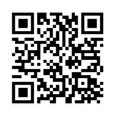
A FRIENDLY REMINDER TO Every shift, you check your equipment—from the bumper line to the backstep. But the hose on your rig isn’t the only one you need to be checking. As April is Testicular Cancer Awareness Month , Mercedes Textiles is partnering with DetecTogether to remind you to check your equipment regularly. Because just like water on fire, early detection saves lives. CHECK YOUR EQUIPMENT Learn how to detect cancer early & request a FREE kit for your station at ResponseTimeMatters.org IN SUPPORT OF

ESCAPE THESE THOUGHT TRAPS
 By Nick Halmasy, MACP, Registered Psychotherapist
By Nick Halmasy, MACP, Registered Psychotherapist
STRESS
28 | CRACKYL MAGAZINE
Many of us believe we have more control over events than we actually do. But divorce, job loss, and grief –they’re all traumatic events that can serve to veer our train right off the track. It’s actually freeing to let go of these misconceptions and relieve ourselves of responsibility for things we can’t control or help.
Don’t get me wrong, there is much that’s positive about accepting your mistakes and taking ownership. Living long enough means we’ll all encounter people who love to blame everyone but themselves. This perpetuates a victim state of mind we may all experience from time to time, but it helps us to recognize the situation and course correct.
In our personal lives, blaming ourselves for everything is a quick way of making sense of our mistakes. We blame ourselves when our partner cheats on us or when we don’t get that promotion. We blame ourselves
ONE SELF-BLAMING TWO
when we aren’t able to save someone. Sometimes these experiences are horrible and painful but actually not really within our control. It’s a massive mistake to assume so.
We can’t control our partner’s actions, the interviewer’s decisions, or the outcomes of our calls. But what we can control is how we feel about those outcomes. Adopting an attitude of learning, adapting, and improving from them is a far more beneficial strategy. Instead of focusing on ways in which we’re responsible for everything, we can instead practice better responses to hard situations.
I get it: as a former firefighter and now as a therapist, I know that at work, worst case thinking is exactly what you need to do to size up a situation. But this strategy falls short when it’s used in our personal lives. Taking stock is one thing, but creating a plan for every worse-case outcome is something different – it’s anxiety. Instead, we need to learn the crucial lesson that is: we can manage. This is a long-lasting answer for hard situations. Rather than developing a plan for everything, we need to learn to trust in our ability to manage the storm.
THREE THE CRYSTAL BALL
How many times have we all said, “If I’d only known then what I know now”? This is called hindsight bias and it is two thinking traps in one. First, it's a form of critical self judgement. We use our current knowledge to judge our previous self – a self that didn’t have the same information. (“If only I’d known the interviewer would ask me about X, I’d have aced that interview.”) In every hindsight situation, we think that if we’d done A instead of B, our lives would be better. But, we rarely have evidence that this would have been the case. It just feels as if it would have been the case and feelings, though important, are not always mirrors of reality.
FOUR FOCUSING ON SIZE
In this case, the trap is minimizing good events and maximizing negative ones. We tend to see positive events easily overshadowed by negative ones. Following a job interview during which we’ve answered everything as well as we possibly could, we then fixate on the one negative moment that occurred. That shadow may hang over us until we hear the employer’s decision – and we later discover that we’ve landed the job.
 HERE ARE FOUR SIMPLE BUT POWERFUL WAYS TO FILTER TOUGH SITUATIONS TO GAIN A CLEARER VIEW OF WHAT’S REALLY HAPPENING.
WORST CASE SCENARIO THINKING
HERE ARE FOUR SIMPLE BUT POWERFUL WAYS TO FILTER TOUGH SITUATIONS TO GAIN A CLEARER VIEW OF WHAT’S REALLY HAPPENING.
WORST CASE SCENARIO THINKING
SPRING 2023 | 29
THE ONLY CHANGE IS IN US, NOT IN OUR SITUATION.


While these four examples are by no means a complete list of sticking points, what’s important is that they’re invisible, until we start to look for them. Our thinking can overshadow everything we do, if we’re not aware of the patterns. We’ll simply believe the reality we’ve created. Thinking, and then acting as if it was real, makes it real. Suddenly, we have real control because we can see a situation for what it is and clearly understand our options. The only change is in us, not in our situation.
CHOOSE CLEAN AIR. CHOOSE PLYMOVENT.


STRESS
Start here

SIMPLE TOOLS FOR YOUR FIRE STATION GYM: THE MED BALL

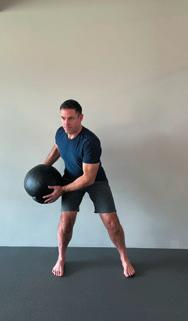

 By Ryan Provencher, Firefighter Peak Performance Founder and Executive Fitness Advisor for CRACKYL Magazine
By Ryan Provencher, Firefighter Peak Performance Founder and Executive Fitness Advisor for CRACKYL Magazine
NO.1 SQUAT PRESS
Begin in an athletic stance, elbows at 90 degrees.
Sit back into a squat position, thighs parallel to the ground.
Press arms forward into full extension.
Pull arms back and return to starting position.
TACTICAL APPLICATION: FRONT LOADED SQUAT MOVEMENTS SUCH AS LIFTING AND OPERATING EQUIPMENT.
NO.2 LATERAL THROW - LEFT
Begin in athletic stance, elbows at 90 degrees, left shoulder to the wall/surface.
Rotate to the right, bending at the knees, loading your right foot.
Drive off your right foot, rotating to the left as you toss the ball to the wall/surface.
Catch and return to starting position.
For lateral throw right repeat technique above, concentrating on the right side.
TACTICAL APPLICATION: ROTATION/ANTI-ROTATION MOVEMENTS SUCH AS FORCIBLE ENTRY.
THE MED BALL IS A SIMPLE TOOL THAT’S INCREDIBLY WELLSUITED FOR FIREFIGHTERS TO BUILD EXPLOSIVE POWER THROUGH DIFFERENT MOVEMENT PATTERNS AND RANGES OF MOTION.
The round shape and soft design are ideal for exercises that challenge stability, reaction time, and hand-eye coordination. I have found crushing a med ball for 20 minutes to be a fun way to build strength and stamina while releasing stress.



FITNESS
A B C D
A B C D
32 | CRACKYL MAGAZINE
NO.3 VERTICAL PRESS/THROW
Begin in an athletic stance with elbows low.
Bend knees slightly, press upward as you throw the ball into the air or to the wall/surface.



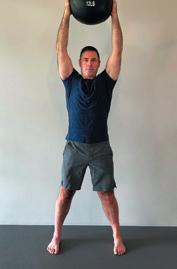
Catch and return to the starting position.
TACTICAL APPLICATION: VERTICAL PUSHING MOVEMENTS SUCH AS BREACHING CEILING.
NO.4 PULL OVER FLOOR SLAM
Begin in an athletic stance, elbows at 90 degrees.
Drive the med ball up and over your head, touching the back of your neck.
Pull the med ball over as you sit back into a squat, slamming the ball to the floor.


Catch and return to the starting position.
TACTICAL APPLICATION: VERTICAL PULLING MOVEMENTS SUCH AS PULLING CEILING.
WORKOUT TRAINING PROTOCOL: 30/30
WARM-UP 10 minute dynamic warm-up.
TRAINING
Perform repetitions of each exercise for 30 seconds. Recover for 30 seconds between exercises. Focus on explosive movement for each repetition. Complete circuit four times.
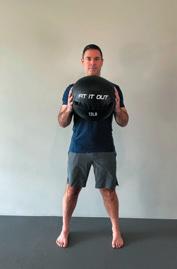
COOL-DOWN 10 minute comprehensive cool-down.
VISIT

MODERATE INTENSITY TRAINING
Maintain Rating of Perceived Exertion (RPE) between five and seven and heart rate between 60 percent and 80 percent of estimated maximum.
HIGH INTENSITY TRAINING
Maintain a Rating of Perceived Exertion (RPE) between seven and nine and a heart rate between 80 percent and 95 percent of estimated maximum.
A B C
THE FIREFIGHTER PEAK PERFORMANCE FITNESS/ WELLNESS PLATFORM FOR EXERCISE VIDEOS, WORKOUT TIMERS, SCORE SHEETS, AND TRAINING GUIDES.
A B C D SPRING 2023 | 33
WHAT IS THE CARNIVORE DIET?
By Danielle Cook, MS, RD, NBC-HWC
There is no shortage of "alternative" diets – paleo, vegan, pescatarian, Mediterranean, keto, you name it. But one of the newest on the block is the carnivore diet. If it walks, swims or flies, according to the rules of the carnivore lineup, you can and should eat it.
Orthopedic surgeon Shawn Baker, a carnivore diet proponent and author of the 2018 book "The Carnivore Diet" makes a strong case for eating animal products. According to Baker’s website, a carnivore diet will get you ripped, cure your depression, reduce joint pain, reverse autoimmune diseases, and much more.
When things sound too good to be true, I get curious, so I did a little research to examine the positives and negatives of filling my plate with pounds of meat.
WERE MOTIVATED TO CHANGE THEIR DIETS

HEALTH
93% A SOCIAL MEDIA SURVEY OF 2,029 RESPONDENTS SHOWED THAT 34 | CRACKYL MAGAZINE
THE CARNIVORE MENU IS LIMITED: BEEF, PORK, LAMB, ORGAN MEATS (E.G. LIVER), POULTRY, FISH, EGGS, LARD, BONE MARROW, BUTTER, SALT, PEPPER, WATER, BONE BROTH, AND GRAVIES MADE FROM MEAT DRIPPINGS ALONE.
Some people add milk, cheese, yogurt, coffee, and tea, but no vegetables, fruit, nuts, seeds, legumes, grains, herbs, spices, cereals, bread, pasta or alcohol. As people adapt to eating only animal products, some report fatigue, headaches, insomnia, changes in bowel frequency and consistency, rashes, joint or muscle aches, and increased thirst—but these symptoms appeared temporary. Advocates of the carnivore diet recommend plenty of water, replacing electrolytes, and resting during this transition stage. Why would anyone severely restrict their diet to just a few foods? A social media survey of
2,029 respondents showed that 93 percent were motivated by health reasons such as diabetes, autoimmune disease, weight loss, and gastrointestinal distress.
The carnivore diet can have positive effects. Because protein is very satiating, there may be weight and body fat loss: when you’re less hungry, you eat less. The lack of variety may cause food to become less appetizing – another boon for weight loss, at least in the short-term.
A drop in caloric intake will result in hormonal changes triggering something called autophagy, a house-cleaning process that rids your body of damaged
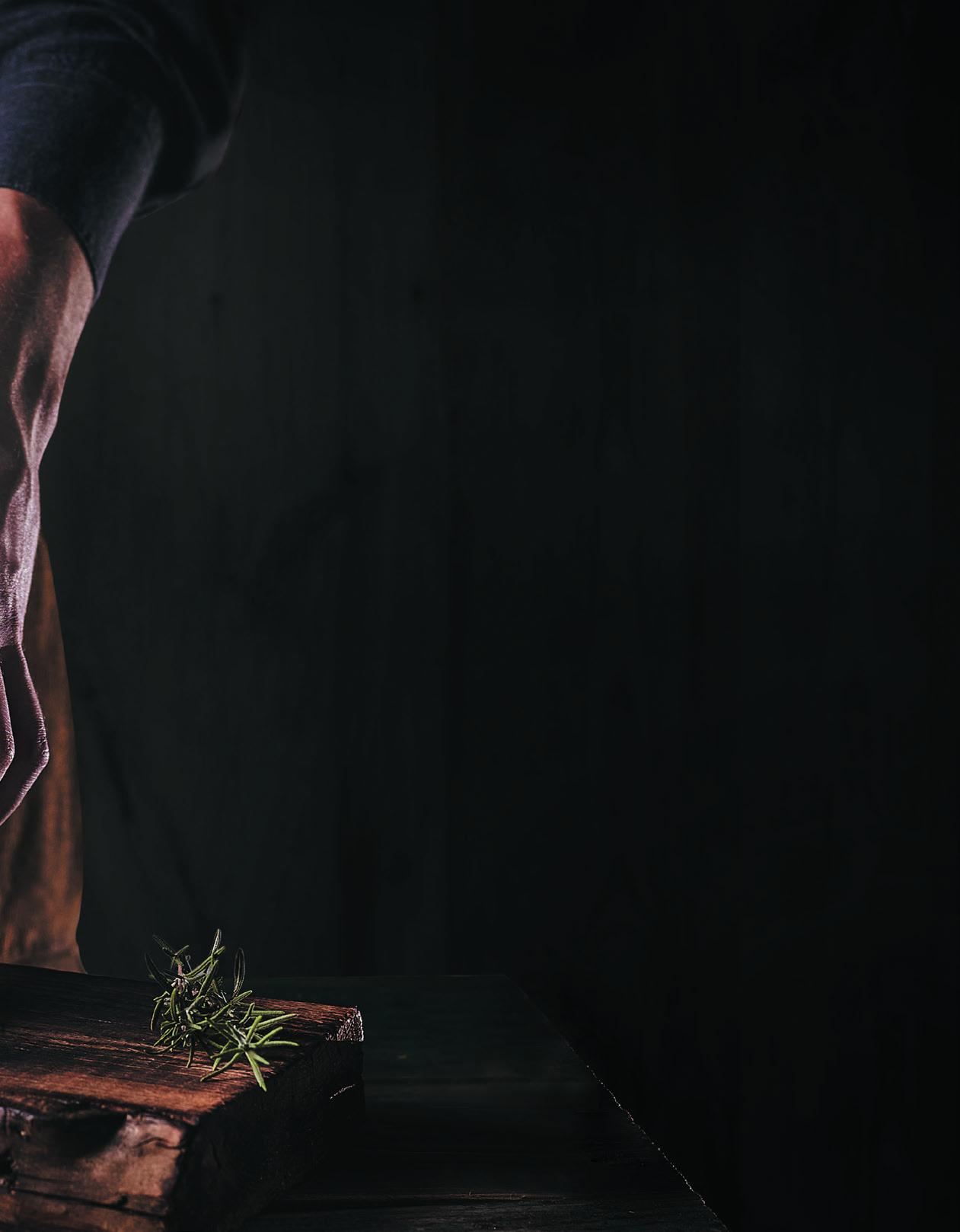
parts that clog your system and cause discomfort. Inflammation and symptoms of autoimmune disease may also decrease.
Eliminating all high-fiber plant foods can allow your gut to “rest”. Meat consists mainly of protein and fat, which are digested and absorbed in the upper region of the gastrointestinal tract; therefore, very little residue makes it to the large intestine where it could potentially irritate the large bowel or an already inflamed intestinal lining. Eating an allmeat diet has also been shown to change the type of microbes that live in your intestines, possibly leading to a reduction in gastrointestinal symptoms.
BUT IS THE DIET SAFE?
There are very few studies on the carnivore diet and none are long-term. Most have a small sample size, are of short duration, and were poorly designed. For reference, however, we can look at cultures with diets high in meat and fat and compare them with ones that include plant foods.
While there aren’t any truly “carnivorous” populations, there are a few groups that consume animal products as their primary food source. The nomads of Mongolia, for example, subsist primarily on meat and dairy products with occasional tubers, seeds, and berries. Some studies attribute their high rates of obesity and cardiovascular disease to that diet. The Canadian Inuit who consume primarily caribou, polar bear, muskox, seal, and fish with occasional berries, grasses, tubers, and sea vegetables not only experience cardiovascular disease as often as the non-Inuit population, but also have a higher incidence of strokes and osteoporosis. Whole-body CT scans of Inuit mummies dating back thousands of years show extensive atherosclerosis (a build-up of plaque in the arteries).
RULES
CARNIVORE
THE
DIET
SPRING 2023 | 35
THESE SELF-REPORTED OUTCOMES ARE PROMISING,
> ATHLETIC

> CUSTOMIZED FIT

CHRONIC DISEASE?
The “Blue Zones” consist of five locations in the world where people frequently live to over largely without chronic conditions like cancer and cardiovascular disease.
INDIVIDUALS IN THESE AREAS TEND TO SHARE COMMON LIFESTYLE PRACTICES:
THEY’RE PHYSICALLY ACTIVE, FEEL A SENSE OF PURPOSE,
AND CONSUME A DIET HIGH
On the Italian island of Sardinia, for example, the typical diet is whole-grain breads, beans, vegetables, and fruits. Meat is eaten only on Sundays and special occasions. In Costa Rica, people living on the Nicoya Peninsula eat almost no processed foods and have a diet rich in black beans, whole grains, fruits, vegetables, dairy, and very small amounts of fish, poultry, meat, and eggs.
On one small Greek island, the Ikarians eat a variation of the Mediterranean diet, including fruits and vegetables, whole grains, goat milk, honey, fish, beans, coffee, potatoes, olive oil and small amounts of meat.
FIRE EAGLE XTREME INTRODUCING
ARE THERE OTHER STYLES OF EATING THAT PRODUCE
> LIGHTWEIGHT
www.haixusa.com FDIC B00TH #912 SEE IT IN PERSON AT STEP INTO A NEW DIMENSION
REQUIRES TO FUNCTION, LONG-TERM?
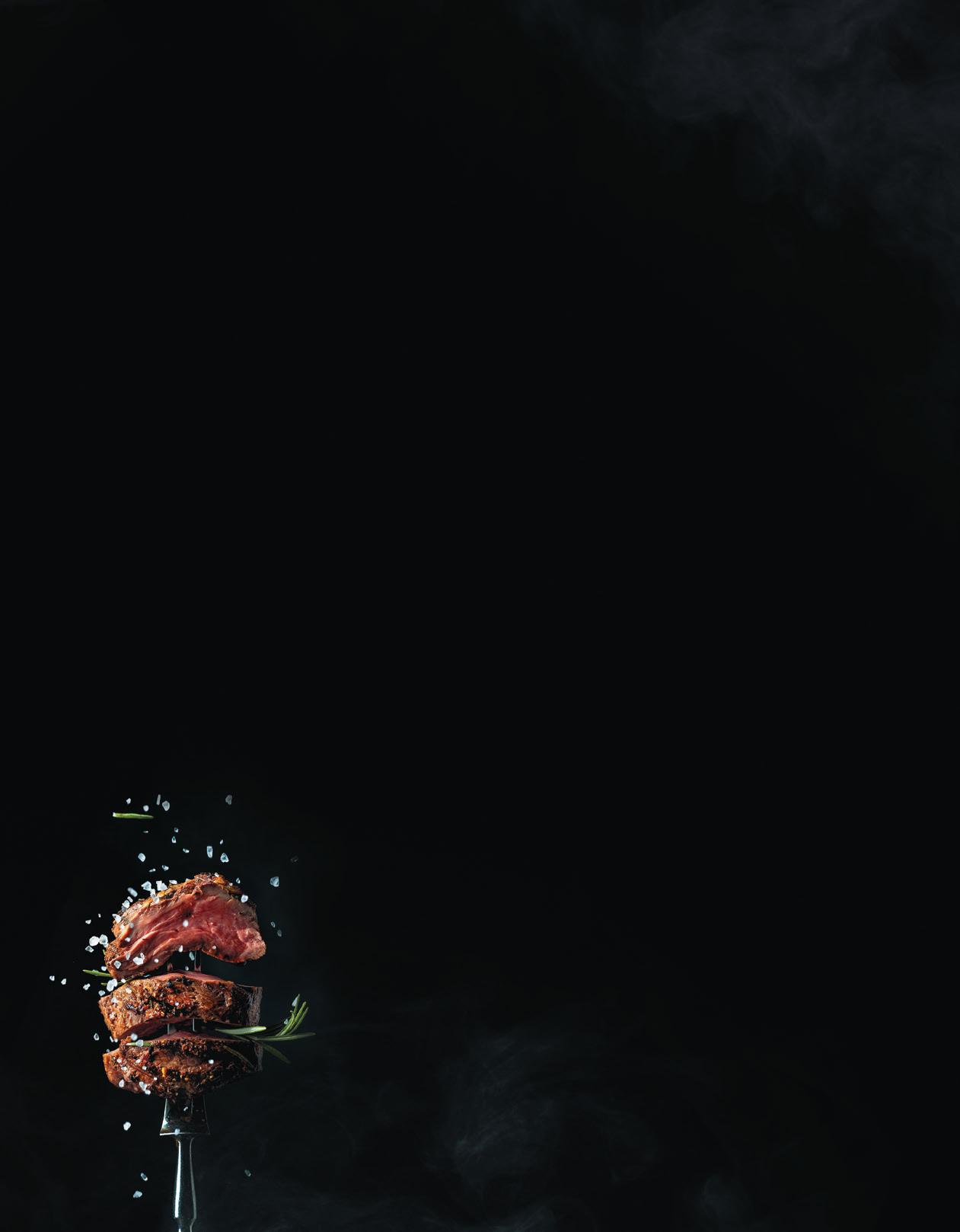
THERE ARE EIGHT MICRONUTRIENTS NOT FOUND IN MEAT: VITAMIN C, VITAMIN E, VITAMIN K, CALCIUM, VITAMIN A, FOLATE, MANGANESE, AND MAGNESIUM.
Including dairy in a carnivore diet will add vitamin K and calcium, while organ meats such as liver, kidney, and heart will give you adequate vitamin A, folate, manganese, and magnesium, leaving just vitamins C and E, which can be taken as supplements. If more than 35 to 40 percent of your diet is protein, you’ll overtax your liver, so fatty cuts of meat are recommended to add more calories and keep you satiated. But cutting out all plant foods means eliminating the beneficial phytonutrients such as the curcumin, betacarotene, and resveratrol produced by plants to protect themselves from insects and disease. Consuming these plant “toxins” triggers a process called hormesis, an acute stressor that forces us to adapt and become stronger. Ingesting phytonutrients has been shown to reduce inflammation, strengthen immunity, repair DNA damage, and increase your body’s natural detoxification process.
My final comment about the value of the carnivore diet concerns elements that aren’t part of the plan. Meats may include toxins such as antibiotics, heavy metals, dioxins, and hormones. Purchasing meats that are “100 percent certified organic” or “free range, no antibiotics”, and “raised without added hormones”, will ensure that you’re not ingesting hormones and antibiotics with your meat - but environmental pollutants such as dioxins and heavy metals will vary depending on where the animal was raised. Because fat accumulates toxins, eating fattier cuts will increase your own toxin load. If you’re consuming fish, eating smaller, wild fish such as mackerel, sardines, and salmon will reduce environmental toxins such as heavy metals and dioxins. And if you’re eating dairy, consuming the organic variety will reduce your exposure to antibiotics and growth hormones.
THE CARNIVORE DIET IS LIKELY SAFE IN THE SHORT-TERM, ESPECIALLY IF YOU INCLUDE DAIRY, ORGAN MEATS, AND POSSIBLY A VITAMIN C AND E SUPPLEMENT. HOWEVER, I WOULDN’T RECOMMEND IT TO ANYONE FOR MORE THAN SIX MONTHS.
I don’t believe every human on this earth is designed to eat the same thing, all the time. Many factors determine what you should eat: genetics, health, food preferences, culture, and your social activities. For long-term health, instead of choosing an all-or-nothing diet try aiming for 50 percent calories from plants and 50 percent from animal sources. If you’re considering trying the carnivore diet to deal with a specific issue such as an autoimmune disease, weight management, gastrointestinal discomfort, high blood sugars, or high blood pressure, think about other, well-studied therapeutic options such as the paleo autoimmune diet, the paleo diet, the and the ketogenic diet. You may also want to investigate intermittent fasting or the fasting mimicking diet.
Find something that will work for you long-term and meet your personal goals. After all, you know your body best.
HEALTH
CAN AVOIDING PLANTS AND EATING ONLY ANIMAL-BASED FOODS PROVIDE YOU WITH THE ESSENTIAL NUTRIENTS YOUR BODY
VERDICT? SO, WHAT’S MY SPRING 2023 | 37
IAFF Responding to the Interface (RTI) Training Program





Fire Fighter Wildfire Response Training
Wildfire is becoming a coast-to-coast problem in the U.S. and Canada. The IAFF is committed to providing effective, consistent training for structural fire fighters who are now responding to wildfires.


Learn

@IAFFofficial
more at IAFF.org/wildfire


A CRACKYL MEMBER TODAY AND INSTANTLY GAIN ACCESS TO EXCLUSIVE TRAVEL DEALS
CAN FOREXCLUS I VE TRAVEL DEA L S DISCOUNTS Travel
CRACKYL MEMBERS
SPECIAL DISCOUNTS
ELSE CRACKYL has partnered with Vacations for Heroes and Member Deals to bring you exclusive discounts on: Flights | Hotels | Concert tickets | Theme Parks & Attractions Movie Tickets | Car Rentals | Cruises | Resorts | & much more!
BECOME
S
HONORING
WITH
YOU WON’T SEE ANYWHERE
JASON PATTON
WHERE THERE’S A LAUGH, THERE’S A WAY
By Leah Sobon
THE BEST-KEPT SECRET IN EMS ISN’T HOW WE KEEP OUR COFFEE WARM (WE DON’T) OR HOW WE’RE ABLE TO STOMACH THE GROSS CALLS (HONESTLY, WE DON'T) OR EVEN HOW WE SAVE EVERYONE (SADLY, WE ALSO DON'T). IT’S OUR UNCANNY ABILITY TO LAUGH AT THE MOST INAPPROPRIATE THINGS...
AND WE COME BY IT NATURALLY.

LIFESTYLE
40 | CRACKYL MAGAZINE
PHOTO BY CATALYST DESIGN AND PHOTOGRAPHY
While it would be nice to suggest that laughter, much like an apple, is the not only the best medicine but can also keep the doctor away, first responders know the second part isn't always true. Jason Patton wasn't the first to figure out how valuable laughter is but he sure is the best. With a never-ending stream of relatable (and hilarious) content aimed at generating bust-a-gut laughter, it’s no wonder that Jason has become a household name for first responders. Whether it’s a remake of an actual call, educating the public, green screens on current TV shows, or comedy based around firehouse antics and (of course) coffee, the hard-working Patton is ready for the challenge. Even if it means getting dirty for the greater good.
Patton wasn’t always a 6’2”, 250-pound red-headed ball of comedic energy. He started off his career a lot like everyone else (though with maybe a bit more hair).
His superpower is his ability to read a room and generate laughter everywhere he can.
“I have always had a layer of humor in me. I had it as a kid going through school. I was the biggest kid in class, with big red fro-y hair. And I just liked to make people laugh. When I got into the fire service, I was the guy entertaining people at the kitchen table. From there, it quickly morphed into what it is now.”
Patton, who is also a mechanic, started working for a private EMS company in 2006. He ended up going to EMT school and ultimately fell in love with it.
“I FINISHED EMT SCHOOL ON A FRIDAY AND STARTED PARAMEDIC SCHOOL ON MONDAY,” SAID PATTON.
With fifteen years invested in both paramedicine and firefighting, Patton is running full steam ahead.

CRACKYL went straight for the jugular and asked Patton which profession he preferred, and to no one’s surprise, it truly is both.
“It’s hard to say because I love EMS for the raw thinking power that's required and the dynamic thought processes. And then I love fire for its animalistic dynamics. I get it from both and I'm blessed.”
“HUMOR IS THE ONE THING THAT REALLY BRINGS US ALL TOGETHER AND ALLOWS US TO BE EQUAL.”
m
SPRING 2023 | 41
PHOTO BY CATALYST DESIGN AND PHOTOGRAPHY
If you’re wondering how he became one of the most popular and recognized faces in EMS, Patton would likely be the first to say he didn’t see coming - which is remarkable considering that he can now be seen on every social media platform and has views that stretch into the hundreds of millions.
If you rewind several years to his first video, filmed using a buddy’s GoPro camera you’ll see Patton, with (in his words), “a really shitty Australian accent”, hunting for the “paramedic” using their natural mating call –bitching. In just eight hours it got over 100,000 views. Clearly, Patton wasn’t the only one looking for a good laugh.
When asked if entrepreneurship was in his blood, Patton explained that his successes didn’t come from an entrepreneurial spirit, but rather from listening to his audience.
“I wouldn’t say I'm an entrepreneur, but if I see something I think I could improve on or add to, then I like going down that path. What I quickly found was that we all have the same sense of humor because we all run the same calls.
“I DON'T BELIEVE I’M SPECIAL. I BELIEVE THERE'S ONE OF ME IN EVERY DEPARTMENT ACROSS THE WORLD."
"What I’ve really found interesting is that the public likes the educational side of things. I have a sarcastic and humorous approach to educating viewers which can sometimes come off as disingenuous, but most people know that's just me trying to lighten it up.”
Patton’s Fire Department Chronicles has a subscribed YouTube audience of close to one million, almost 600,000 followers on Instagram, and millions upon millions of views on TikTok. Despite the pressures that come with being a first responder, he was happy about the slow climb to success with Fire Department Chronicles.
“I'm very glad it's been a slow progression. I didn’t get catapulted into any of this – it was slow steps leading to where I am, and I'm very happy because I think with a lot of this stuff, you have to be humble and grateful and thankful. I don’t take any of this for granted and I understand that the only reason I’ve
been successful is that I’ve listened to people about what they like and don’t like. And I understand that all of this could go away tomorrow. That’s why I’m still a full-time firefighter.”
In addition to his work on the Fire Department Chronicles, being a fulltime firefighter and part owner of Fire Department Coffee, Patton is also a major advocate for first responder mental health. He always appreciates hearing firsthand from his followers just how much his honesty about his own mental health has meant to them.

“As I moved more into mental health – and talked about how I needed to reach out to someone – I had so many reactions from people saying 'Thank you. You legitimize people's thought processes. You legitimize people’s struggles.’ And I think that's what this is. You need people constantly. I’m not giving myself any credit here, but you need people that have a spotlight, and who also aren’t the typical person you think would talk about their feelings.
“I’M A COMEDIAN, 6’2”, 250 LBS, AND I’M A FIRST RESPONDER. I’M NOT THE TYPICAL PERSON THAT YOU THINK WOULD TALK.
LIFESTYLE
m
42 | CRACKYL MAGAZINE
PHOTO BY CATALYST DESIGN AND PHOTOGRAPHY
"I get the honor to travel the US and speak about Mental Health and how I’ve dealt with my struggles. It’s called How to Hug 101 – I (comedically) talk about how crying is as normal as laughing which is as normal as being angry. These are all normal feelings and I think that's the biggest thing. I’ve had people say ‘Hey man, I wasn’t going to go in (for treatment) but then I heard you talk about your struggles.’ One individual wrote a few days back to let me know he was eight months sober.”
Patton doesn’t take his role lightly, despite his jibs and jabs at his profession. He knows how valuable his platforms have been for others, and feedback is something that continues to fuel his initiatives.

“I think it's teaching people to breathe. If you get into something and you don’t know what the hell is going on, you need to take a breath.”
my phone down and watch TV then I sit down and watch TV.
"When I originally started doing the videos, I had a guy reach out to me on Snapchat. He said ‘Hey man, we just got back from a really bad call, bad MVC with casualties.’ He said that all the guys were sitting there trying to process what they’d just gone through. One of the guys got on his phone and saw one of my videos. They all watched it together and laughed. It kinda removed, not the sadness, but the staleness of the situation and brought them out of the dark for a second. It allowed them to have a free moment in their brains and then they were able to open up and talk about what they had gone through.”
Patton is also a husband and father, and balancing his home life and his work is a constant struggle that he isn't shy to talk about.
As he puts it, “Anyone who tells you to leave work at work and home at home is stupid. They just don’t know your brain doesn't work like that. I’m pretty good about disconnecting from work, assuming I'm satisfied with my shift.
“I’m turning forty this year and I don’t expect a kid who is twenty to do this – they can’t. I think it’s trying to find the best balance that you can, then giving yourself leeway. We are humans. From the day you were born you were taught it's either zero or 100, that's it. And as firefighters and paramedics, when you walk in the room you have to be 100 percent and that's not possible – it’s just not.
And he adds: “Yes, there is training and we have to show up on calls and be good – but I think the number one thing for anyone on a busy schedule is to have perspective and be a little lenient with yourself. You have to have an understanding that there will be days when you can go 110 percent and get everything you need to get done, then go to bed very satisfied. And then there are going to be days when you just can’t do it. You think, I’m tired, I only had four hours of sleep and my family needs me. That’s the basic understanding I’ve tried to have in my life and with my own emotions. There are some days when I’m going to be super happy and others when I’ll be struggling. It’s all normal, very normal.”
Keeping balanced in his chaotic schedule is something Patton works hard at – but he is the first to admit that it isn’t always a smooth ride. “Fitness is one thing: I love working out. And it doesn’t have to be me slamming weights on the ground. Just moving for twenty minutes is what I try to do. Or even sleeping in. Or if I want to sit on my ass and put
“Firefighters, men, and first responders in general don’t want to use the word ‘feelings’. But it’s the permission thing, I swear to God, it’s understanding. It can be three minutes. I can be doing a bunch of stuff and have people reaching out to me, and I get super overwhelmed. I’ll put my phone down, make a drink or sandwich, eat that, and by the time I get back to my phone again, I feel better and am ready to tackle things.”
Patton can vividly recall a four-month stretch where he spent the majority of his time working, traveling, and talking at conferences – which he is always thrilled to be a part of. But it was exhausting. That experience taught him just how important realistic self-expectation can be when it comes to personal bandwidth.
“I learned a lesson. But I think a lot of it has been trial and error. And my wife has been unbelievably amazing. I try to stop my days at 3:00 pm when we are going to pick up my daughter. But my wife has picked up the slack immensely for me. My department has also been unbelievably understanding of all of this.”
“FEEDBACK IS WHAT HAS GIVEN ME A LOT OF INSPIRATION."
“FIREFIGHTERS, MEN, AND FIRST RESPONDERS IN GENERAL DON’T WANT TO USE THE WORD ‘FEELINGS’ m
SPRING 2023 | 43
PHOTO BY CATALYST DESIGN AND PHOTOGRAPHY
Jason Patton’s story is far from over. He recently announced that he’s working on putting together a new TV show highlighting EMS/ firefighting departments across the world – but not aimed at a first responder audience. This is being done for the general public, to bring them a slice of the world of first responders, to explain why first responders do what they do and go where they go. He has seen firsthand how much the general public has benefited from his content and can’t wait to see where this will go.

“TikTok is where I really saw the need. There were a bunch of young kids there and they wanted to know why you can't run through a four-
YOU CAN MAKE A PATIENT'S DAY BETTER BY CRACKING A JOKEn
foot wall of fire. And when I put up my CPR video, which had millions of views, people began wanting to know about CPR.”
Patton is definitely someone to watch. His ability and his passion to expand his content relies on firsthand experiences – which he isn’t short on. He plans to keep creating and wouldn't mind making a guest appearance on “Tacoma FD” one day. He has even offered to be a sacrificial lamb. (Former CRACKYL cover boy Steve Lemme, “Tacoma FD” exec producer and star: are you listening?)
“Humor is good, on every level,” says Patton. “Talking about mental and physical health helps educate people by removing the stigma of the situation. You can make a patient's day better by cracking a joke, and I think what it really does is connect all of us – first responders and humans in general. It's the one thing that really brings us all together and allows us to be equal, if even just for a moment.”
LIFESTYLE
FIND JASON PATTON’S VIDEOS ON TIKTOK, YOUTUBE AND INSTAGRAM: @ FIREDEPARTMENTCHRONICLES
44 | CRACKYL MAGAZINE
PHOTO BY CATALYST DESIGN AND PHOTOGRAPHY
Hitting personal bests in the gym matters more when lives are on the line. It’s why we created the essential supplements firefighters need to stay fit for whatever the alarm bell brings.


15% off with code CRACKYL15
FireScienceNutrition.com
6 lbs .......... Helmet 22 lbs .......... Turnout Gear 35 lbs .......... SCBA 42 lbs .......... Battering Ram 55 lbs .......... Steel Door 103 lbs ......... Full 13/4 Inch Attack Line 110 lbs ......... 14-year-old Boy 224 lbs ......... A Fellow Firefighter
why Casual Casual Destroying Sex is your relationships
By Carrie Fleetwood, M.Ed., R.P.
casual sex often involves risk and that can be part of the attraction and thrill for first responders.
sex. Is there anything more simply natural and at the same time completely complicated? Given how much attention sex gets in the media (and in our own minds) you’d think humankind would have it completely figured out by now. But...maybe not.

RELATIONSHIPS
46 | CRACKYL MAGAZINE
What about “casual sex”? How exactly casual is casual? The official definition could be “any sexual activity outside of a committed relationship”. And here’s the kicker:
Attachment theory offers convincing, documented evidence that for good mental and physical health, human beings – both men and women – desire and need love, secure attachment, dependable, safe relationships and community.
Research has shown that what really matters in a good relationship is accessibility and responsiveness. Anything that destroys safe emotional engagement and bonding threatens a sustainable intimate relationship. Casual sex falls firmly into that category.
Everyone now knows that there is a direct correlation between smoking and lung/heart/cancer disease. There is also a direct correlation between indulging in casual sex and an inability to maintain a loving, satisfying marriage or long-term relationship. Is there such a thing as a healthy amount of smoking or a harmless amount of casual sex?
And are first responders more susceptible to casual sex?
Casual sex often involves risk and that can be part of the attraction and thrill for first responders. Used to living with highs of
adrenaline and intensity at work, first responders sometimes find casual sex and the risks involved very alluring as the spiking adrenaline takes off. The nature of the job, spending long days and nights with others who live and work in the same intensity, can set the stage for casual sex and affairs.
Casual sex almost always involves divorcing the heart from the body as it is usually physical pleasure devoid of love and intimacy. Modern western culture has sold us the lie that we should pursue pleasure for “me” and that “I’m entitled to be happy”. When we use another person, even in marriage, we dull both our soul and theirs to our genuine needs and to the true longings of the heart as we become selfish and self-oriented.
But what about “friends with benefits” and so-called “mutual arrangements” or “paid sex”? Does casual sex really harm anyone? In most cases when a mutual arrangement starts, one party is hoping that selling himself/ herself out may actually create a relationship. If all goes well, it might just become permanent. Unfortunately, much like masturbation, casual sex leaves you feeling more empty and more alone.
While pleasurable arousal occurred in the body, the aching needs of the heart remain.
The human heart is meant for secure, loving, and reliable attachment but society is filled with broken and sometimes abusive relationships. Should we give up on our ideals and settle for something far less satisfying and perhaps even destructive?
When people settle for casual sex it may be because they feel they can’t seem to maintain a long-term relationship or they’re afraid of committing. Some people may be afraid of feeling trapped or “owned” and fear connecting body and soul in a relationship. Some may not really know how to love their spouse deeply because they didn’t experience unconditional protective love growing up. Other people may be running from responsibility or internal pain and depression, or they may have a sexual addiction and fear placing unreasonable demands solely on their partner. Still others may use sexual activity to avoid facing internal losses and the unmet dreams of the heart.
The choice to engage in casual sex is yours but it’s important to recognize the cost to your life and future. Beyond the
obvious risk of pregnancy or intentional entrapment through pregnancy, there are other damaging effects you’ll have to deal with.
The most common is the inability to remain faithful and honestly love the partner that you have or hope to have. Between relationships or separated from your spouse and thinking casual sex will fill a gap in the meantime? The truth is, you’re likely to end up feeling even lonelier. The “between” place offers a great opportunity to get moving on the many things that you were always going to do such as taking up a sport, an instrument or a new language, learning about communication, getting fit, or stopping drinking. Sexual intercourse and love-making within a loving committed-forlife relationship actually releases “love chemicals” in the body that increase acceptance and desire for your partner and promote greater tolerance for minor conflicts.
Sex is the icing on the cake in a great relationship, not the cake itself.
Tempted by casual sex? Think long-term and choose healthy commitment!
SPRING 2023 | 47
casual sex actually goes against everything the human heart longs for.
The Spiritual Life of a First Responder
By Rabbi Howard A. Cohen, Deputy Chief (Ret.), member of the National Volunteer Fire Council
I am a rabbi. I’ve served congregations in Alaska, Massachusetts, and Vermont, and was a prison chaplain for five years in Pennsylvania. I was also an active firefighter for 20 years, entering the fire service world as a department chaplain, and retiring as a deputy chief. Today, I remain active as an instructor for the Africa Fire Mission. For a long time, I’ve been exploring matters of spiritual health in diverse settings, especially the fire service world. None of this makes me an authority by any means, but it does afford me a certain perspective on the topic of spirituality and the fire service.
A lot of people think they know what spirituality means but many have a hard time defining it. This isn’t surprising because understanding spirituality is a highly subjective matter. For the purpose of this article, therefore...

LET’S DEFINE SPIRITUALITY AS A SENSE OF MEANINGFUL CONNECTION TO SOMETHING BEYOND OR BIGGER THAN OURSELVES.
For many of us in the fire service what we do isn’t just a job, it’s a vocation. We do what we do, and face the
challenges we face, because we are called to help others and we are self-sacrificing. We train to save lives under extreme conditions. Every time that tone drops, we’re answering a higher calling.
We may not think of what we are doing as spiritual work, but for those we help during the worst hours of their lives, our work must seem spiritual. For them, we are practically divine agents. We may not use words like spirituality, higher calling, and holy when we are thinking and talking about our work, but in my opinion, the fire service is nothing less than holy work.
Beyond the holy nature of our life-saving work, I believe there’s something spiritual in the way we bond with our colleagues. We trust our lives to one another and the lives of those we help depend on our ability to work together. At the end of a day of soul-wrenching experiences, we cry, hug, and support one another because we have a spiritual connection. There’s a lot of talk in today’s fire service about emotional wellbeing.
HEALTH
48 | CRACKYL MAGAZINE
EMOTIONAL WELLBEING
is about cultivating a frame of mind that can broaden your outlook and help you connect to something larger, something beyond yourself. Emotional wellbeing involves accepting and exploring who you are, enhancing your inner resources to reduce stress and maintaining a positive outlook on life. It’s about developing an awareness and an acceptance of the way you feel.
SPIRITUALITY & SPIRITUAL HEALTH
by contrast, are about actively seeking meaningful connections with something larger or beyond yourself which can result in positive emotions and personal growth.
PUT SIMPLY, THE DIFFERENCE IS THAT SPIRITUALITY STARTS WITH LOOKING OUTWARD, WHILE EMOTIONAL WELLBEING STARTS WITH LOOKING INWARD.
The two are deeply integrated and, in fact, reinforce one another. Unfortunately, the daily challenges of working in the fire service take their toll – adrenaline carries us only so far. Eventually, all the fires, car crashes, accidents, damaged bodies, and deaths can turn what began as a calling into a grueling job as the demands of the profession can slowly chip away at our spiritual health. Being a firefighter not only brings us into direct contact with trauma and tragedy, but also demands that we act, not feel.
Over time, as we become habituated to not processing our emotions, our emotional wellbeing and spiritual health can begin to suffer. Left unchecked, this may lead to burnout and/or secondary traumatic stress that can impact our health and relationships. Our work may start to feel meaningless and the connections to our colleagues will start to fray as we literally become dispirited.

As dire as this sounds, there are many ways to regain and sustain spiritual health. Try incorporating some of the following suggestions into your daily life to strengthen both your spiritual wellbeing and emotional health.
DEVELOP A STRONG SENSE OF GRATITUDE
This can be as simple as making a point of expressing gratitude every day to the people you connect with. Take time every day to be thankful for the work others do for you and express your gratitude.
INVEST IN YOUR RELATIONSHIPS
Invest time and energy in the people you love and who love you in return.
2 3
EMBRACE RITUALS
The life of a firefighter is filled with important daily safety tasks. Embrace these tasks as sacred rituals and as you go through your checklist, visualize how they connect you to your colleagues, remembering what might happen to them if you didn’t do this task correctly.
MEDITATE AND/OR PRAY
FOSTER EMPATHY FOR OTHERS
Pay close attention to the people who surround you, then expand the empathy you feel for those you know to encompass those you haven't met but may be helping.
Work on your spiritual health by questioning, affirming, and revising your beliefs. Drill down on troubling thoughts instead of hiding them from yourself. Share your thoughts and discuss your concerns with someone you trust.
While spirituality may incorporate elements of religion, they are neither the same thing, nor entirely distinct from one another. Religion is about following a prescribed set of rules, traditions, or beliefs, while spirituality is entirely subjective and can be defined any way you choose. Some people express their spirituality by preserving aspects of a traditional religion they enjoy, like the practice of prayer or a belief in a God. This is fine—as is the choice to express your spirituality in other ways. Ultimately, there is no right or wrong way to seek spiritual meaning. It’s all about our individual choices.
what’s the difference between emotional wellbeing, spirituality and spiritual health? 1 4 5 SPRING 2023 | 49
Harnessing the DragonMoney
 By Gregory Gordonson
By Gregory Gordonson
Two loving people sharing a life... doesn’t that sound easy?
ASK A MARRIAGE COUNSELLOR ABOUT THE BIGGEST BONE OF CONTENTION BETWEEN WARRING PARTNERS AND THE ANSWER WILL LIKELY BE MONEY.
Yours. Mine. Ours.
Who brings it in? Why is there never enough? Who gets to spend it? How much of it should be saved?
Money is a sensitive issue because it is so often tied to our personal values, beliefs, and emotional needs, including security, independence, and control. When partners come from different financial backgrounds, their goals and spending habits can
be so opposite that they cause serious friction. Arguments about sharing financial responsibilities, allocating funds, and dealing with debt versus savings can shake even the most loving partnership to its core.
If a successful financial union is a simple matter of adding two lives and two paychecks, subtracting what it takes to live comfortably and then multiplying the gains year by year, what’s the problem?
It’s that last element of basic math – division.
Unless both partners are on the same page when it comes to budgeting and financial plans, each person may be working towards different –and potentially conflicting – goals, creating feelings of confusion
and frustration. Keeping financial secrets from your partner can create a division that could cause serious harm ranging from misunderstanding and lack of trust to difficulties tracking expenses. Without honestlyshared financial information, it’s impossible to plan for the future, save for retirement or buy a home.
Financial conflicts can take a serious toll on even the most loving partnership. When there are difficulties in agreeing about common financial goals, stress mounts, satisfaction with the relationship plummets and communication falters.
Financial conflict within a family can also have negative effects on children, creating stress, anxiety, and insecurity that can harm their emotional and mental well-being. Financial conflict
FINANCE 50 | CRACKYL MAGAZINE
between parents decreases family cohesion, increases tension, and takes a huge toll parent/child relationships. If the financial picture becomes very dark, it may even challenge the children's future financial stability, education, and career goals, and will certainly skew their own views and beliefs about money.
If bills go unpaid, there can be serious damage to credit scores that can threaten future financial stability and even lead to legal disputes. That’s why it's so important for couples to discuss their finances, set
Add, then multiply.
mutual financial goals, and work together to resolve any conflicts that may arise.
WHEN PARTNERS DON’T SHARE THEIR FINANCIAL GOALS – OR IN SOME CASES, THEIR ACTUAL RESOURCES – THEY END UP CREATING A TWO-HEADED DRAGON THAT SHOOTS FLAMES IN OPPOSITE DIRECTIONS.
As a firefighter, you know very well the power that can come from harnessing the power of two to make one, so consider these tips to turn your partnership into a single, powerful financial dragon that will blaze a trail into a comfortable future.

1. Communicate openly: Before committing to a shared life, both partners need to be aware of each other's attitude to money, their financial goals, expenses and debt obligations. Start by having open and honest conversations about your spending habits, your hopes for the future and any questions you might have. And don’t have just one chat. Maybe pick a date for an annual update such as an anniversary.
2. Set joint financial goals: Identify and prioritize the things that matter most, such as paying off debt, saving for a down payment on a house, or building an emergency fund.
3. Divide and conquer: This is where division can be a good idea! Decide how you will divide financial responsibilities, such as bill paying and tracking spending, to ensure that both partners are involved and informed.
4. Make a budget: Create a budget that takes into account both partners' income and expenses and make a plan for allocating income and prioritizing expenses. Consider both short-term and long-term goals and be sure you’re both on board.
5. Reduce your debt: Pay off high-interest (such as credit card) debt first and do your best to avoid taking on new debt.
6. Save for emergencies: Set aside money for unexpected expenses, like job loss, an illness, a family crisis or unexpected medical bills.
7. Plan for retirement: It may seem as if it’s light years away but if you start contributing even modestly to a retirement account now, you’ll thank yourself later.
8. Review your insurance coverage: Make sure you have adequate insurance for health, life, and property to cover you both.
9. Invest together: Consider taking a course in financial planning and think about carefully investing in stocks, bonds, or real estate to build wealth over time.
10. Avoid lifestyle inflation: It’s far too easy to increase your spending as your income grows, but if you’re smart, you’ll continue to live within your means and save whatever you can.
11. Be wary of impulse purchases: Yes, you’d both love to own a boat — but is it in the financial cards this year? Avoid making impulsive purchases that could disrupt your budget and rock your long-term financial plans.
12. Get some professional advice: Talk to a financial advisor so you can develop a comprehensive financial plan to keep you on track to reach your goals. Schedule regular financial check-ins to review your progress and make adjustments as necessary.
13. Be supportive: Be supportive of each other's financial decisions and work together to make compromises when necessary.
don’t let your finances become a furious two-headed dragon in your life!
SPRING 2023 | 51
hot FlasheS in the hot zone
By Anastasia Miller, Ph.D.
WHEN I WAS YOUNGER, IT WAS CONSIDERED HORRIFIC TO EVEN MENTION “AUNT FLO” (OUR NICKNAME FOR WOMEN’S PERIODS) IN MIXED COMPANY! LUCKILY, WE’VE SEEN A LOT OF BREAKING OF SOCIAL TABOOS AROUND THE SUBJECT OF WOMEN’S BODIES IN RECENT YEARS. MENSTRUAL CYCLES, WHEN THEY START AND WHEN THEY END, ARE NORMAL HUMAN FUNCTIONS.

While we now have hilarious TV commercials for feminine products that actually use red liquid (instead of baffling blue as in the past), and we seem as a society to have a better understanding of the importance of medical tests such as pap smears and breast exams, there is still a lack of communication around one monumental landmark of womanhood: menopause.
Even those who think they know something about menopause are often misinformed. I’ve encountered people who think every woman goes through menopause at a set age (false), that it means that a woman has run out of eggs (also false), or that it never lasts long (very false).
HEALTH
52 | CRACKYL MAGAZINE
Let’s start by setting the record straight about what menopause is, so we can all be on the same page and normalize the discussion. The medical definition of menopause is “the point at which it has been twelve months in a row since a woman has had any bleeding” (i.e. her period). Menopause can happen naturally as early as age thirty right up to sixty or beyond. It can be induced by surgery (such as a hysterectomy) or the use of certain drugs (chemotherapy). For the average woman, menopause starts in the early-to-late forties or early fifties. The transition can be very rapid (such as when it is surgically caused) or it can take up to fourteen years. On average, it lasts for approximately seven years.
The time leading up to menopause is known as “perimenopause” – a stage when the ovaries start to produce estrogen and progesterone randomly rather than regularly. Women may begin to experience a host of symptoms including “hot flashes” (sudden feelings of heat, typically in the upper body, including perspiration, sometimes accompanied by anxiety) – which can be triggered by anything from caffeine to strenuous activity.
Perimenopausal women may have difficulty sleeping, experience sudden irregular periods
and sudden weight gain, bladder control issues, and mood swings. There can be changes in sexual interest and comfort as well.
The story differs for every woman. For some, the symptoms are mild to begin with, and get stronger. Others report feeling as if they’ve hit a brick wall all at once, while others have few symptoms. There can be huge variances even between sisters in the same family. Because menstrual cycles will be difficult to chart and ovulation will be unpredictable, it’s wise to still practice birth control during perimenopause.
After menopause, women enter a period known as “postmenopause”. During this time, they are at an increased risk for heart disease, weight gain, memory issues, osteoporosis, and stroke. While it may be a relief to no longer have their periods, they may unfortunately still experience hot flashes for as long as another fourteen years. While birth control will no longer be needed, it’s important to remember that women can still catch sexually-transmitted infections. Any bleeding experienced after menopause is not normal and should be checked by a medical provider.
Menopause is not a “disease” to whisper about in dark corridors, it is simply a stage of life
caused by changes in hormones. In fact, menopause is not unlike the so-called male menopause (more properly called andropause), that occurs when men naturally experience a reduction of testosterone in middle age, resulting in loss of muscle mass, mood swings, lack of energy, memory issues, and difficulty sleeping. There are some distinct differences and the two are not directly comparable (the rate of decline of testosterone in men is steady, as opposed to menopause, which is a sudden, drastic change in hormone levels) – but it is important to remember that all bodies change as we age.
How can the brotherhood/ sisterhood support fellow firefighters who might be going through menopause? Given that nearly one in five female firefighters report it being an issue, there are some basic tips to consider. Never assume a woman is going through menopause, but simply provide a safe space with resources she can access, and offer a listening ear. Clarifying medical leave and absence policies can help, as some of the symptoms of menopause – such as depression or extra heavy bleeding –may require time off.
The job is physical and that might induce hot flashes or put women at
risk for bone injury or even osteoporosis. Ensure that there are ways to cool down, check in with a medical provider, or take a day off to recover. Keeping extra uniforms on hand in women’s sizes, particularly shirts, for when the hot flashes hit, can be a great relief as can looser-fitting uniforms. To lower core temperature immediately, women should be allowed to remove bunker gear/outer clothing when not required if they are overheating. On scene, things such as cold water and ice packs can help. Muscular strength may lessen more quickly as a result of hormonal changes, and bone density may also decline. To counter this, a proper diet and exercise routine should be encouraged.
Keep in mind that menopause is still a sensitive, even embarrassing issue for most women. Designate someone willing to be a representative for women’s issues – perhaps someone in HR or an outside person who stops by periodically – who can relay issues to officers.
If we all accept that menopause is simply another stage of life (and have an extra shirt and an ice pack on hand) we can support our sisters while doing the job we love so much.
LOOKING FOR MORE ANSWERS? THE OFFICE OF WOMEN’S HEALTH WEBSITE ON MENOPAUSE OFFERS RESOURCES AT WOMENSHEALTH.GOV/MENOPAUSE . THE NATIONAL INSTITUTE ON AGING ALSO HAS A FREE TOOL TO HELP YOU LEARN ABOUT YOUR SYMPTOMS AND CREATE A PERSONALIZED TREATMENT PLAN MYMENOPLAN.ORG
SPRING 2023 | 53
MENOPAUSE IS NOT A “DISEASE” TO WHISPER ABOUT IN DARK CORRIDORS


westbroadapparel.com hose hats | shield hats | Apparel |drinkware use code “crackyl10” for 10% off your next purchase. KEEP TRADiTION ALIVE
MORE

TOUGH TOXINS ELIMINATED *
Proven more effective in the reduction of high molecular weight PAHs than any other personal decon brand tested
IT ISN’T SOAP. IT’S SOOTSOAP.

CHANGE YOUR STATS.
*Removal of tough-to-eliminate high molecular weight (HMW) polycyclic aromatic hydrocarbons (PAHs) versus washing with water alone
INFO@SOOTSOAP.CA WWW.SOOTSOAP.CA IG @SOOTSOAPSUPPLYCO
UP TO8x
By Josoph Kozikowski, Firefighter, City of Appleton Wis. Master Nutrition Coach (PN2), NSCA-Tactical Strength and Conditioning Facilitator (NSCA TSAC-F), Pain Free Performance Specialist (PPSC)
Eat To Thrive Together

HEALTH
56 | CRACKYL MAGAZINE
I recently had a conversation with a health-conscious firefighter who was just about to finish his probation. We were discussing strategies for how he could fit in with a group of senior firefighters without making himself a total outcast at the dinner table. Referring to an enormous station meal consisting of a burger with, in lieu of a bun, grilled cheese sandwiches on the top and bottom (can't believe you didn't invent that?), he said simply, "I'm just trying not to kill myself at the dinner table."
It’s hard to argue that these aren’t words to live by. So why is this such a hard concept for the fire service to accept? It’s because, for many, this means change.
Change is hard, really hard, even when we have a supportive environment and all too often firefighters are shooting themselves and others in the foot without even knowing it.
Let’s start by acknowledging a little fact. (We can keep this inside the firehouse, though…) Those stubborn, aggressive, hard-charging flame eaters you work with are far more sensitive to needing to feel accepted than they will ever admit. Yeah, you too. And, OK, me as well.
EVERY TIME WE HARASS SOMEONE FOR MAKING BETTER CHOICES AT THE DINNER TABLE, WE’RE UNINTENTIONALLY STOPPING PROGRESS.
It may seem like no big deal… something that’s just part of the culture, but I'm here to tell you that
it really hurts those who might be inspired to change, not the “fitness fanatics” who are already set in their ways. (Scratching your head?)
THE BEGINNING OF ANY PERSONAL CHANGE COMES WITH FEELINGS OF AMBIVALENCE, AND ANY RESISTANCE DURING THIS TIME CAN KEEP PEOPLE FROM STAYING ON A HEALTHIER PATH, OR EVEN STARTING.
When I get called out for not eating a dessert or switching a burger for a salad, even though I’m solid in my resolve, it does sting a bit. For those new to healthier eating, the need to feel accepted, coupled with the instant gratification of super-bad-for-you-butso-delicious food can far outweigh the results they will see weeks down the line.
Let’s consider how change, especially concerning nutrition and fitness, happens. It starts with a little spark, just a thought, perhaps triggered by a little bit of shame or desire. It could be that a glimpse in the mirror leaves us unhappy, or we notice how out of breath we were on the last fire call, or how sore we were after lifting a hefty medical patient, or maybe we’ve had some undesirable numbers come back on a blood test. Then, seeing someone else's success might create a twinge of desire, along with a realization of what could be possible.
Then we think. Maybe I should start “X” or maybe I should stop “Y”... but if I do that, then this might happen. Mixed feelings about change can last quite a while, and might linger even after positive action has begun.
It's a step that won’t happen without an emotionally-compelling reason. That change-making emotion must be stronger than the outside pressures to conform.
The emotions that surround change are either where magic happens or the point at which we get kicked back to square one. Someone trying to implement change will be forced to fight their own mental resistance while they form new habits. Support during this time will make all the difference while any added resistance – intentional or not – from outside sources can easily cause failure.
Outside resistance, in my opinion, is the number one reason why nutritional and fitness change is so hard inside the firehouse. The following is a real statement from a fellow firefighter: “Losing weight here sucks. You have to opt out of dinner and then everyone hates you.”
The facts may be false, but the sentiment and emotion behind the words are true.
WE CANNOT CONTINUE TO CULTIVATE AN ENVIRONMENT WHERE FIREFIGHTERS ARE MADE TO FEEL LIKE OUTCASTS FOR DOING THE RIGHT THING, WORKING ON THEIR HEALTH, AND IMPROVING THEIR PERFORMANCE ON THE JOB.
You can take action today by simply implementing some of these suggestions to help support some positive habit changes.
SPRING 2023 | 57
I'm just trying not to kill myself at the dinner table.
ways to support others if you're trying to change
Maybe we dial back the double grilled cheese monster burger to either a burger OR a grilled cheese. Small nutritional changes in the right direction add up.
If you've teased someone about trying to make a change, be sure to offer a compliment on the effort they're making later on.
Keep ingredients for a large meal like sauces, pasta, proteins, veggies separate and serve “a la carte” style to allow people to portion appropriately for their goals.
Skipping dessert can be tough for many, so don't push the issue. You do you, let them be.

Make the gym welcoming. It is very tough in an environment like the fire service to admit you have let yourself go, so why not support a firefighter getting back into a physical routine in any way possible? Just like we shouldn't be actively killing ourselves at the dinner table, there is also no need to try and actively kill someone in the weight room!
Self compassion! Know that change is hard for everyone. You are not alone. Many others have fought the same demons and many have found victory: what one person can do so can another. There will be setbacks – that’s part of the process. Reflect on them, forgive yourself, and keep moving forward.
Know that when you make healthier choices, those around you will take note of their own unhealthy choices. This can make some uncomfortable. That is not your responsibility. You do you.
The job is more predictable than people like to make it out to be. Anticipate challenges, strategize and set yourself up for success on shift and at home.
Consistency is the key. A focus on basic nutritional strategies of hydration, getting enough protein, and eating mostly healthy foods will get you there. The more consistent you are, the less harassment you will take, and when you find success you absolutely will inspire others.
It is not an all-or-nothing proposition. Give yourself some grace and enjoy a dessert, when it’s worth it, and go all in on the big retirement dinner. We work in a culture where firefighters' names from long ago are remembered by recipes they made. You don’t need to miss out on this. Simply make these occasions the exceptions, not the rule.
HEALTH 58 | CRACKYL MAGAZINE
It is time to acknowledge and respect the courage it takes for a firefighter to change his or her health in an environment where they will be picked apart for anything and everything. Take action to create a station environment where our words and actions support a healthy fire service culture. Let’s push and support each other to be the best responders we possibly can.








Outside resistance, in my opinion, is the number one reason why nutritional and fitness change is so hard inside the firehouse.















LEARN MORE SCAN ME ZERO EMISSIONS ALL MX FUEL BATTERIES FIT ALL MX FUEL™ EQUIPMENT 14" CUT-OFF SAW
SIGN UP AND SAVE 40% ON A FIRE DEPARTMENT PRINT SUBSCRIPTION. SCANAND SAV E 40% TODAY

CUSTOMIZE YOUR ORDER AND GET CRACKYL DELIVERED TO ALL OF YOUR FIRE STATIONS. BY SUBSCRIBING TO CRACKYL, YOU’RE GIVING YOUR FIREFIGHTERS ACCESS TO THE BEST TOOLS IN FITNESS, FINANCE AND MORE!

10.75"

COMICS

SPRING 2023 | 63
SAIL INTO Adventure!
MAKE THIS THE YEAR TO DIVE INTO CRUISING
 By Liz Fleming
By Liz Fleming
With all the advantages of an all-inclusive resort, a cruise adds the excitement of experiencing many different destinations. Even better, someone else handles getting you from A to B and you unpack your bag only once! Whether you pick a sultry Caribbean cruise or bundle up to explore the Arctic (or the Antarctic), setting sail can be an unforgettable way to vacation.
LIFESTYLE 64 | CRACKYL MAGAZINE
Size does matter!
RIVER OR OCEAN?
Cruises can be divided into two general styles: river and ocean. Ocean cruises can be subdivided further into big ship and small ship, including expedition ships. The difference is size.
OCEAN CRUISE SHIPS ARE FAR LARGER THAN THEIR RIVER COUSINS – SOME OF THE BIGGEST CAN ACCOMMODATE MORE THAN 7,000 GUESTS.
They can feature dozens of restaurants, theaters, cafés, shops and event spaces which can include casinos, shopping promenades, go-cart tracks, climbing walls, water parks with continuous surfing waves and multi-storey slides, skating rinks, giant outdoor movie screens, Broadway-caliber productions and more. The largest ships are like floating resort towns, making the
vessel itself the holiday destination. Even smaller ocean cruise ships offer a range of onboard amenities including casinos, spas, bars, pubs, pools and a range of dining and entertainment choices. At the smaller end of the ocean-going category, expedition ships accommodate fewer guests and offer less variety in onboard dining and entertainment, but sail to exotic destinations like the Antarctic and the Galapagos Islands, sometimes providing incredible amenities like helicopters and submarines to make exploring more fun!
RIVER CRUISE SHIPS ARE LONG, SLENDER VESSELS THAT TYPICALLY ACCOMMODATE BETWEEN 100 AND 200 GUESTS IN SUITES WITH LARGE WINDOWS OR BALCONIES.
Designed for calm waters, these ships typically sail on rivers in Europe (by far the most popular destination), Asia, Egypt, South America and some parts of the U.S. There is usually just one main restaurant, although some ships also offer an additional private dining area for small groups or a grill on the open-air top deck (when weather permits). In addition to the restaurant, there’ll be a lounge with a bar, where guests gather for drinks and enjoy the nightly entertainment and ‘‘port talks" – information sessions led by the cruise director. River cruise clients are often older, well-travelled, and love immersive cultural experiences.
Whatever your travel tastes, there’s a cruise to satisfy your appetite.
FAMILY FUN
RIVER OR OCEAN? FAMILY FUN
Many cruise ships cater to the younger members of the family and some that are particularly good include Royal Caribbean, Norwegian and, of course, Disney. Not only will you find life-size (and larger!) mascots roaming the decks, you’ll also enjoy a wealth of kid-focused entertainment opportunities from cartoon movies by the pool to mini golf courses on the top deck and
animated wall art in the specialty restaurants—and much more. Many ships offer babysitting services and connecting staterooms with large shared balconies, perfect for multigenerational gatherings. Bring the kids and Grandma and Grandpa too!
While the littlest sailors will be keen on meeting Mickey and Shrek, the teens (often a tough crowd to please) will appreciate climbing walls, basketball
courts, swimming pools and go cart tracks, while their parents will love the all-inclusive theater in the main dining room, the poolside grill and the buffet area, where even the hungriest teen will never go hungry. Best of all, you don’t need to hold the reins very tightly when your teenager is on a cruise. The ship is a well-enclosed area and the bars all check for ID!
SPRING 2023 | 65
SAIL WITH THE BEST SAVINGS AT SEA

Heroes Vacation Club offers firefighters exclusive cruise deals and up to $1,500 in onboard cruise credits. Explore travel discounts and access to hotels, resorts, car rentals, theme park tickets, and much more.




JOIN TODAY, SAVE TODAY Scan QR to Join For Free or visit HeroesVacationClub.com Promo Code: Crackyl to join with Premium Savings for 60 Days
HeroesVacationClub.com/terms-and-conditions
Heroes Vacation Club guide at 1-877-867-3639. 0041-2023
The 60-day free trial begins at the date of your account activation. No credit card required. Premium Membership will end 60 days after you create your account unless members choose to enroll in Premium membership for a cost. Destinations and travel times are subject to availability. Additional travel costs, mandatory all-inclusive fees, taxes, and other expenses are not included. Additional terms and conditions apply and will be provided at time of booking. Program rules subject to change. Certain benefits, products, and services may only be accessible to Premium Members. For additional terms and conditions, visit
or call your
CRUISING FOR COUPLES CRUISING FOR COUPLES
Has it been far too long since you treated yourselves to quality time together?
Eager for a holiday where no one cooks, does dishes or even makes the bed?
A cruise checks every box, whether you opt for a wine-focused river cruise where every day takes you to a different vineyard or winery, or an ocean voyage where you loll by a shimmering pool and take shore excursions to island beaches and markets. The bliss lies in the totality of the service onboard. When neither of you has any responsibilities, there’s suddenly time to reconnect.
If you choose an ocean-going ship, one of the great treats will be the nightly live entertainment. In our day-to-day world, entertainment means either heating up dinner and burrowing back into Netflix or an expensive night out. Onboard a ship, you’ll not only have the luxury of choosing from a selection of restaurants but will also have a variety of included live entertainment ranging from musical
revue shows to comedians, magicians, acrobats, singers, dancers and more. The lineup changes daily so you’ll feel as if you’re out on the town every night. Some of the best lines for entertainment and great dining include Holland America, Oceania, Celebrity, and Viking.
Expedition ships focus most attention on the daily shore excursions which often involve Zodiac (sophisticated rubber raft) trips for wildlife viewing, SCUBA diving or snorkeling, or hiking adventures. Night time entertainment is typically a presentation by an onboard expert who’ll explain what you’ve just seen or might hope to see in the coming days. Because you’re usually up early and have active days, you’ll head to bed early too and so won’t mind not having a casino or theater show. Some of the best expedition ship companies include Silversea, Ponant, National Geographic, and Adventure Canada. Some fabulous river cruise lines include Avalon, Scenic, Emerald and AmaWaterways.
BRINGING A GANG? BRINGING A GANG?
A cruise is a great way to gather a group of buddies or a collection of couples while leaving a bit of space in your togetherness. While you certainly can choose to sign up for all the same shore excursions, you don’t have to. Some friends may stay onboard to loll by the pool, while

Best Advice?
others head off to explore. Some might gather for dinner in the main dining room while others choose a specialty restaurant and have a romantic dinner for two. The options are endless and can offer exactly what’s needed to keep a group happy together – and apart!
Get some…advice that is. Whether you’re booking your first cruise or signing up for your twentieth, a conversation with a well-informed travel consultant is a great idea. They’ll sort through the hundreds of options out there to find the cruise that’s perfect for you. And the advice you’ll receive about promotions, special deals, new itineraries, ship upgrades and more will be invaluable.
LIFESTYLE
SPRING 2023 | 67
Firefighters experience symptoms of depression, anxiety and sleep issues at a higher rate than the general population.* Alcohol increases these symptoms and creates additional risk for other serious health conditions.
Understand and address the mental and physical effects of the job, with strategies and resources that can improve your overall health.

The reasons for not using alcohol are numerous –but so are the rewards.
more at nami.org/FrontlinePublicSafety * Jones S. Describing the Mental Health Profile of First Responders: A Systematic Review. J Am Psychiatr Nurses Assoc. 2017;23(3):200-214. doi:10.1177/1078390317695266
Learn
MIXING ALCOHOL & FIREFIGHTING IS A
DEADLY COCKTAIL
By Rick Markley, Science Alliance
IS HEAVY DRINKING LINKED TO WHAT’S ALREADY KILLING US?

HEALTH SCIENCE ALLIANCE
SPRING 2023 | 69
IN THE 1960S AND 1970S, THE FUN DRUNK GUY WAS A STAPLE ON TV SHOWS.
The Andy Griffith Show’s wholesome hometown of Mayberry had Otis – the town drunk who got laughs by locking himself in jail when he’d had a snootful then letting himself out in the morning after he’d sobered up.
Most of Dean Martin’s stage and television comedy persona was built around him always being drunk and ready for debauchery. While he was rarely seen without a cocktail in hand, his children later claimed Martin’s drunkenness on stage was just an act and that his glass held only apple juice.
The truth about heavy alcohol use is far more sobering than entertaining. Hardcore drinkers are rarely as harmless and loveable as Otis and can, in fact, be a wrecking ball freewheeling through life. Those drink-induced antics are more than a few one-offs – they point to deeper troubles.
Though we’ve known for decades about alcohol’s gripping, addictive powers,

understanding the nature of that addiction and how to best break it has been long debated.
Like Dean Martin, part of the firefighter mystique is that we are a bunch of hard drinkers. Unlike Dean Martin, we have actual scientific research showing there is truth to the myth – there’s more than apple juice in our glasses.
Two studies led by Science Alliance founder Dr. Sara Jahnke and her team at NDRI-USA showed that 45 percent of career firefighters reported heavy drinking (considered more than two drinks at one time for men, and more than one for women) and binge drinking (five drinks for men or four drinks for women over a two-hour period) over the previous month.
Volunteers were only slightly better, with 39 percent reporting heavy drinking and 45 percent reporting binge drinking.
Think this is only a guy problem? Think again.
Jahnke was also part of a team of researchers who looked at alcohol
WHAT MAKES A DRINK A DRINK?
When scientists talk about an alcoholic drink, they mean 14 grams of absolute alcohol. Here’s what that looks like in real life:
• ONE 12-OUNCE BEER AT 5 PERCENT ALCOHOL
• ONE 7-OUNCE MALT LIQUOR AT 7 PERCENT ALCOHOL
• ONE 5-OUNCE GLASS OF WINE AT 12 PERCENT ALCOHOL
• ONE 1.5-OUNCE SHOT OF DISTILLED SPIRITS AT 40 PERCENT ALCOHOL (80 PROOF)
consumption among female firefighters. Overall, female drinking numbers closely followed those of male firefighters. Two interesting exceptions were that women were more likely than men to completely abstain from alcohol, but were also more likely to be heavy drinkers – they were less likely than men to be both moderate and binge drinkers.
“When nearly half of those in the fire service are drinking excessively, often to dangerous extremes, we have an institution-wide problem,” Jahnke says. “Our culture of heavy alcohol use is contributing to our own literal demise through acute and chronic illnesses affecting both body and mind.”
Heavy drinking will often lead to problems at work, relationship troubles with family and friends, legal issues and physical injuries. These are all documented and well-understood. It is also well understood that these drinkrelated life challenges only compound the stress that comes from being a firefighter. In short, we know drinking is a bad coping mechanism for stress and usually makes matters worse.
HEALTH
70 | CRACKYL MAGAZINE
It is equally well known that excessive drinking will cause long-term health issues such as liver disease and will also wear down other vital organs already compromised by firefighting.
Like excess stress, alcohol abuse negatively affects heart health –cardiovascular events are a leading cause of firefighter death and injury. Dr. Robert Kloner, a professor of medicine at the University of Southern California says alcohol in excess “can cause high blood pressure and promote arrhythmias. It can cause cardiomyopathy where the alcohol is actually toxic to the heart muscle cells, and that can lead to heart failure.”
Equally disconcerting are the links researchers are now making between alcohol use and cancer. This news is especially disturbing when combined with results from large studies and analyses of smaller studies that show the firefighting community has as much as a 20 percent greater risk of developing cancer than does the general population.

In 2022 the World Health Organization’s International Agency for Research on Cancer gave the occupation of firefighting its highest classification, Group 1 carcinogenic to humans. That means simply being a firefighter is known, not just suspected, to cause cancer.
And that 20 percent greater risk gets a lot scarier when you dive into the weeds of specific cancers. The IARC singled out four types of cancer and showed the increased risk for firefighters and the even greater risk for firefighters who have more than 3.5 drinks at a time. Have a look at the box above.
ORAL, BUCCAL AND PHARYNX CANCER:
40 PERCENT GREATER RISK FROM FIREFIGHTING AND 83 PERCENT GREATER RISK WITH DRINKING.
ESOPHAGEAL CANCER:
39 PERCENT TO 59 PERCENT GREATER RISK FROM FIREFIGHTING AND 123 PERCENT GREATER RISK WITH DRINKING.
Take a moment to swallow the numbers above. Even in the best-case scenario for colon cancer, the risk is nearly 50 percent greater when you stir in heavy drinking. The worst case scenario can more than triple your chances of getting throat cancer.
“Be honest with yourself,” Jahnke says. “If you consider yourself a moderate or social drinker, do you believe 3.5 drinks in one night is heavy drinking? Probably very few of us would. And as the number of drinks go up past 3.5, so too do the chances of developing different cancers. We have to completely recalibrate the way we look at our relationship to alcohol if we want to cut our risk of cancer.”
There's more bad news for firefighters report that they smoke, even if only when they drink. Research has found there is a strong interaction between smoking, alcohol and cancer development. This mix particularly increases the risks of mouth and throat (oral cavity and esophageal) cancers.
Jahnke was part of a team of researchers who looked at the relationship between smoking and drinking among firefighters in 2015. They found that the firefighters in their study who smoked were seven
LIVER CANCER:
30 PERCENT GREATER RISK FROM FIREFIGHTING AND 54 PERCENT GREATER RISK WITH DRINKING.
COLON CANCER:

14 PERCENT TO 21 PERCENT GREATER RISK FROM FIREFIGHTING AND 25 PERCENT GREATER RISK WITH DRINKING.
times more likely to drink heavily and five times more likely to binge drink.
While much of the research tying firefighter alcohol use to firefighter cancer is fairly recent, scientists have suspected there was a connection for decades. A 1989 study led by researchers at Johns Hopkins University found that daily alcohol consumption was associated with cancer-causing markers in firefighter blood tests. While that study focused on the cancer risks of smoking and eating char-broiled food, it noted that daily alcohol use may interfere with detoxifying enzymes that degrade carcinogens from products of combustion.
Even back then, it seemed alcohol was a compounding factor in the cancer risk firefighters faced.
“The causes of cancer in the fire service are multi-pronged,” Jahnke says. “We have to take control of as many variables as we can to put the odds of good health in our favor. Controlling alcohol consumption is as much a cancer-prevention measure as is wearing SCBA and cleaning turnout gear after a fire.”
Alcohol overuse may still be entertaining in some quarters, but aside from maybe comic Tig Notaro, nobody thinks having cancer is funny.
FOR MORE INFORMATION ON THE SCIENCE ALLIANCE AND TO ACCESS THIS AND OTHER FIREFIGHTER HEALTH AND WELLNESS RESEARCH FINDINGS, VISIT SCIENCE-ALLIANCE.ORG SCIENCE ALLIANCE
71
FART THE ART O F THE
A SHORT HISTORY OF FLATULENCE
By Martha Chapman
Ancient Romans giggled over them. In the 1500s, a British aristocrat left the royal court in shame after letting one rip in front of Queen Elizabeth I. And since the beginning of time, we have cooed and chuckled when babies emit adorable wee ones.
We are speaking, of course, about farts. Officially known as flatulence, farts are little explosions of air (often accompanied by a sulphuric smell) that are the evidence of the activity of the bacteria in your gut as it helps move waste through your body. As air builds up in your system it has to find a way out, and there are only two options: burping or farting.
APPARENTLY WE FART BETWEEN FIVE AND 25 TIMES A DAY.
If it’s any consolation (and it won’t be to your sleeping partner or firehouse mates) we fart more when asleep, when both social conventions and our sphincters are more relaxed.
On the good news front, flatulence is actually good for you, and a necessary part of digestion. It signals a healthy digestive tract and helps your bowels move. And we all do it, from presidents to beauty queens to your mother-inlaw – and in every corner of the world including Denmark, where a fart is a “prut”, Germany (“furz”) and Holland (“scheet”). In New Zealand, apparently after some people fart in public they say “An empty house is better than a bad tenant.” (For more international hilarity, check out “Funniest fart commercials” on YouTube. I did, in the cause of research for this story.) Spend enough time in the truck with your crew and you’ll be able to identify each member’s particular “brand” of farts.
SPEND

ENOUGH TIME IN THE TRUCK WITH YOUR CREW AND YOU’LL BE ABLE TO IDENTIFY EACH MEMBER’S PARTICULAR
“BRAND” OF FARTS.
72 | CRACKYL MAGAZINE
WHAT BRINGS ON FARTS?
Many vegetables, including beans (remember that huge batch of chili you cooked up for the firehouse crew a few weeks ago?), lentils, cabbage, kale, broccoli, cauliflower, Brussel sprouts and asparagus. Lots of these are called cruciferous vegetables. If that sounds familiar, it’s probably because you’ve heard how good they are for you, thanks to their high vitamin C content and potential cancer-fighting properties. Bran, milk/dairy and eggs can also bring on the flatulence orchestra. And yes, it all gets worse with age.
WHAT IF YOU’D LIKE TO CUT BACK ON YOUR FARTING?
Recommendations include drinking more water, eating smaller meals more frequently, and eating slowly. Avoid soda and beer, with all their gassy bubbles. Even gum-chewing or drinking through a straw can result in your ingesting more air, which, as we have learned, has to come out somewhere. And, if need be, there are over-the-counter remedies designed to help cut down on your fragrant emissions and make you significantly more popular at the firehouse.
When does farting become more than an embarrassment and morph into an actual health concern? When it is accompanied by cramps or bloating, nausea, vomiting, diarrhea and/or bloody stools. Then it’s time to seek medical attention.

So what ever happened to that aristocrat who “cut the cheese” in front of Queen Elizabeth I back in the 1500s? Evidently he was so ashamed he left the court, travelling for seven years before slinking back, whereupon the Queen greeted him with “My lord! I had quite forgotten about the fart.” A claim to fame indeed.
facts farT fuNMORE
A FEW MINUTES FARTING ABOUT ON THE INTERNET REVEALED SOME ASTONISHING FLATULENCE TRIVIA, INCLUDING:
NICKNAMES FOR FARTS INCLUDE: AIR WALNUTS, CHEEK SQUEAKS AND BUTT BURPS.
YOU EXPEL MORE GAS WHEN YOU ARE STANDING UP.
IN 1781 BENJAMIN FRANKLIN WROTE AN ESSAY CALLED "FART PROUDLY".
ACCORDING TO GUINNESS WORLD RECORDS, THE OLDEST JOKE IN THE WORLD DATES BACK SOME 4,000 YEARS AND WARNS HUSBANDS ABOUT THEIR BRIDES FARTING IN THEIR LAPS.
APPARENTLY SOME PEOPLE ARE AROUSED BY FARTS. (EW AND PEE-YEW!)
JANUARY 7 IS NATIONAL PASS GAS DAY.
SPRING 2023 | 73
ARE YOU READY FOR THE FIREGROUND?
As a firefighter, you’re not only required to develop your tactical job skills but also the physical fitness that improves the efficiency of those skills.

Increasing your techniques for tasks at work will decrease the amount of effort required when you perform them in the field. Building your physical fitness level may allow you to perform the same tasks for a longer period and decrease the impact that each individual call has on overall strain per shift.
Today’s fire departments are not just employers: they are increasingly active in educating employees about fitness, wellness and nutrition. Tactical strength and conditioning instructors placed within agencies have the job of strategically programming physical fitness training to target the muscles, movement patterns, and energy systems of common fireground tasks.
To best prepare for these tasks, whether it’s for emergency calls or for passing physical ability tests, you need to prioritize exercises that have a higher carry-over to increase your job task performance.
Four specific tasks are commonly recognized in the firefighting community: forcible entry, victim drag, kneeling hose pull, and stair climb.
Since fireground tasks incorporate a large portion of posterior chains musculature (such as glutes, hamstrings, and back) and rotational power, we focus on these areas and share training exercises that can easily be built into your physical preparedness regimen to increase muscular development, strength, power, and endurance that will assist job task performance.
Each exercise here has a description you should have a look at before you do it, as well as cues to assist you to better understand the setup and execution of the exercise. In addition, each exercise has an alternative (working similar muscle groups and movement patterns); a regression (an easier exercise option); and a progression (a more advanced exercise option).
IMPROVING STRENGTH AND POWER PERFORMANCE FOR COMMON FIREGROUND TASKS
FITNESS
74 | CRACKYL MAGAZINE
By Hussien Jabai, MS, CSCS, TSAC-F, CPT and Firefighter Kelton Brewer
FORCIBLE ENTRY (STRIKE MAN)
INTENSITY: HIGH
INTENSITY: MODERATE COMPONENTS:
• Rotational power (core) – ability to transfer power in a rotational movement pattern to strike the Halligan tool.
• Upper body endurance – ability to strike the Halligan tool repetitively during forcible entry.




STAIR CLIMB (W/LOAD CARRIAGE)
COMPONENTS: COMPONENTS:
• Lower body strength – ability to lift and move victim.
• Lower body endurance – ability to transport victim for a greater distance.
KNEELING HOSE PULL
INTENSITY: MODERATE COMPONENTS:
• Lower body strength – ability to perform stair climb with additional load.

• Lower body endurance – ability to complete multiple flights of stairs.
• Core stability – ability to maintain upright position while carrying hose bundle.
INTENSITY: HIGH
• Upper body power – ability to pull sections of hose in a dynamic and explosive manner.
• Rotational power (core) – ability to rotate in a dynamic manner while pulling sections of hose.
VICTIM DRAG
Firefighter photography by: Firefighter Tyler Wine Exercise photography by:
Escobedo Featured Personnel: Firefighter Kelton Brewer and Firefighter Christian Sutter
fireground
SPRING 2023 | 75
Jose
These photos are demonstrating common
functions not workouts.
KETTLEBELL DEADLIFT
ASSOCIATED TASKS: VICTIM DRAG & STAIR CLIMB
PREREQUISITE
Personnel should be able to demonstrate proper hinge mechanics, potentially developed through non-weighted glute bridge, body weight hinge, or even hinge with banded tension.
PRESET CUES
• Pull shoulders back; focus on keeping a flat back and chest out.
• Keep your chin tucked through the movement and do not look up.
• Core tight: focus on bracing your core by creating tension to support stability and structure.
DESCRIPTION
The deadlift, commonly known as the “king” of all the hinge movements, emphasizes posterior chain load. Although mostly seen as utilizing the standard barbell, the implementation of a kettlebell can be beyond beneficial for personnel new to working out or readdressing proficiency of movement patterns.


INVERTED ROWS
EXECUTION CUES
•“Knees” – Without squatting, slightly bend your knees to initiate the movement.
• “Sit” – push hips backwards, not straight down (think of sitting back into a chair).
• “Brace” – when you grip the kettlebell, emphasize drawing your shoulders backwards, tucking your upper arm into your lats; create tension in your core for support.
• “Hips” – while maintaining a flat back and tight core, drive your hips forwards to lift the weight.
• “Stand” – as you drive your hips forward, think of standing tall; do NOT extend into a lean.
ASSOCIATED TASKS: KNEELING HOSE PULL & VICTIM DRAG
PREREQUISITE
Due to the ability to manipulate the intensity/difficulty of this task based on body positioning, primary prerequisites could consist of grip strength or glute strength for maintaining posture through movement.

PRESET CUES
• Grip the handles or straps; take the slack out of the strap by walking outwards before initiating your lean.
• From a leaning position, adjust the difficulty based on your current fitness level and goals – traditionally, the more you lean, the higher the intensity/load.
• Engage your core while pushing your hips forwards – this helps keep your body in proper alignment during the movement.
DESCRIPTION
The inverted row is a full body movement that manipulates body weight to increase load and intensity of movement for developing musculature of the back. This musculature provides structural integrity for many fireground tasks.

EXECUTION CUES
• Drive your elbows backwards – your body will start to rise with this movement.
• While pulling, keep your elbows either at 45 degrees from your side or tucked against your body.
• Toward the end of the movement, squeeze your shoulder blades together to fully contract your back muscles.
• Reverse the movement by slowly allowing your body to lower, stretching your back muscles and extending your arms in front of you.
• Make sure you maintain a straight body alignment even at the bottom of the descending motion.
FITNESS
76 | CRACKYL MAGAZINE
WOOD CHOPPERS (WITH MEDICINE BALL)
ASSOCIATED TASKS: FORCIBLE ENTRY & KNEELING HOSE PULL
PREREQUISITE
Show efficient thoracic or upper spine/torso rotation in a controlled manner.
PRESET CUES
• Select a medicine ball of a weight that you can control in both a slow and dynamic movement – start light before increasing the load.
• Stand with your feet at hip width.
• You should have a slight bend in your hips at the start position.
EXECUTION CUES
• While grabbing the medicine ball with both hands, place it on the side of one hip.



DESCRIPTION
The rotational nature of the wood chopper trains the core to twist with high-speed movement patterns. Training the core with dynamic rotational exercises will prepare the body to be explosive in a controlled manner during job tasks that require rotational power production.
REVERSE LUNGE (WITH SANDBAG)
• Begin to drive your hips forward (with a slight rotation) to generate power in your rotation
• As you drive your hips forward, rotate at the core while raising the medicine ball across your body over the opposing shoulder – your chest and torso should rotate and follow the motion of the ball.
• Rotate as your mobility allows, while ending the motion when the medicine ball is over that opposing shoulder.
PREREQUISITE
Personnel should be able to perform proper squatting mechanics to display a baseline of lower body strength prior to single limb movements. Personnel should also perform the movement efficiently without weight prior to adding any form of load carriage.
PRESET CUES
• Grasp, lift, and securely place the sandbag on one of your shoulders.
• Use one or both hands to maintain the sandbag positioning – might be determined based on weight of the bag and/or coordination.
• Keep your core engaged throughout the movement.
EXECUTION CUES
DESCRIPTION
The reverse lunge is a very underrated exercise that addresses overall lower body strength and stability through movement. Any offset of load carriage, such as holding a dumbbell or sandbag on one side, increases the dependence on core engagement.
• Shift your weight toward the leg opposing the sandbag – this will be your support leg.
• Initiate the movement by lifting and pushing back the leg that is on the same side of the sandbag into a reverse lunge.

• Consciously focus on the placement of the back foot, and maintaining the stability of that ankle.
• Sink your hips downwards until your knees reach a 90 degree angle, or as far as you are comfortable.
• As you initiate lunging forwards into the starting position, drive the hips forward with the support leg – engaging the glutes.
• You can either place the foot of the moving leg beside the support leg on the ground or allow for the foot to hover over the ground to maintain the tension of the support leg.
ASSOCIATED TASKS: VICTIM DRAG & STAIR CLIMB
SPRING 2023 | 77
GET YOUR ANNUAL FIREFIGHTER PHYSICAL.
You can’t rescue anyone if you don’t take care of yourself first. Getting your annual firefighter physical can help you be sure you’re there — to save others.

For more information, visit firstrespondercente r.org.

YOU CAN’T SAVE OTHERS IF YOU DON’T save yourself.




DRIVE FORWARD. SURVIVE THE CHALLENGE. LIVE TO SERVE ANOTHER DAY. INDIVIDUAL TRAINING SOLUTIONS THAT KEEP YOU ON THE LINE. Save 20% with ID.me verification! To schedule an EDUCATION COURSE contact us at TRXELITE@TRXTRAINING.COM for specific requests or additional information. TRAINING TOOLS TO ENGAGE THE ENTIRE DEPARTMENT. Register your department and instantly receive a discount!
THE BENEFITS OF OVERSHARING AT THE FIREHOUSE
By Simon Matthews, MHlthSc FASLM
RELATIONSHIPS
80 | CRACKYL MAGAZINE
TMI? NOT!
EVER BEEN HIT BY A FLOOD OF TMI?
Have you ever had someone tell you something that was a massive overshare? Way too personal, to the point of making you feel uncomfortable? Something that made you want to yell “Dude…TMI!!!”
WE’VE ALL BEEN THERE.
But, by contrast, we’ve probably also had someone else share similar, very personal information that we’ve been completely okay hearing. Context is everything. It’s all about who you’re with, the nature of your relationship with that person and how important they are to you.
I was lucky enough to take a tour of Kennedy Space Center at Cape Canaveral, Fla. late last year and was fortunate to book a spot on the Launch Director’s tour. The Launch Director, who had retired at the end of the shuttle program, told us that his responsibilities had been to oversee the entire process of launching and returning a shuttle after a mission. He had been the director at the time of the final shuttle launch in 2011, as well as the tragic re-entry break-up of Columbia in 2003. And it was clear to everyone who listened to him that he was still deeply moved by that event. But it was his description of how he approached his work that really got my attention. First, he described his job as making sure the shuttle didn’t launch. In other words, he needed to be beyond satisfied that every aspect of the mission was in place and going according to plan before he would give the final launch order. A part of his motivation was his sense of personal responsibility for each of the astronauts on board any shuttle mission. This responsibility was something he believed was essential to their safety. He knew all the astronauts intimately – their likes, dislikes, their favorite foods and fondest memories. And he knew their partners, children and extended family too. He would spend hours and hours with the families over many months of preparation for
a launch, getting to know them in a way very few others in their lives knew them. This deep and intimate connection strengthened in him a sense of responsibility and a desire to do everything in his power to ensure that they all returned to Planet Earth safely.
First responders seem to get this. They share stories about their intimate relationships, their health and the challenges they may be facing, as well as the embarrassing situations they have found themselves in. To an outsider, it might seem like a massive overshare. But is it? And if so, why does it matter?
We’d be smart to wonder what function this behaviour serves, and how we can understand it better.
Why do babies cry, sometimes loud and long? It’s a way of drawing attention to an urgent need they have. Maybe they need food, comfort, pain relief or sleep. When your partner sits quietly in a corner at home, not saying much, it’s easy to dismiss his or her behavior as sulking. But what function might that behavior be serving? There’s a good chance it could be indicating that they need some time and space alone, or – at the other end of the spectrum, that they are signaling a need for more connection or closeness with you. Maybe they are waiting for you to initiate an approach. Don’t you sometimes wish people were more communicative?
So what might be the function of over-sharing? What might it signal? I think it may be a way of saying: “I want you to know me so well that you’ll look out for me.” When we feel closely connected to someone, they matter more to us. When they matter more, we look out for them. If that is the purpose that over-sharing serves, then thinking about it as TMI isn’t helpful. In fact, it’s just the right amount of sharing, and just the right amount of information to make the type of connections that are so important for first responders.
" " 81



NEW MEMBER BENEFIT NVFC First Responder Helpline - 24/7 confidential mental health services. National Volunteer Fire Council Member Benefits Become a member for only $21/year! JOIN TODAY AT WWW.NVFC.ORG/JOIN EMS/RESCUE SECTION Join and receive a complimentary EMS/Rescue Section membership. Training Free online training through the NVFC Virtual Classroom. HEALTH $10,000 AD&D insurance policy, NVFC First Responder Helpline. MEMBERS-ONLY RESOURCES Guides, grant-writing resources, and Train Strong webinar series. COMMUNICATE Access to Volunteer Voices online member community. SPECIAL PROMOTIONS Eligibility to apply for gear giveaways and educational scholarships. DISCOUNTS Discounts on online universities and fire service training, gear, etc. $
Part of being able to work to the best of your ability as a first responder is knowing that others have your back – in the same way that you have their backs. We can’t have our attention everywhere all the time, so it’s vitally important to know that any danger we haven’t seen could be noticed by someone else who’s looking out for us. Humans are most likely to care for those they’re closest to. If you had one organ to donate and it could go either to your child or to a stranger, who would you select?
If you created a list of things that would help to keep you safe on the job, no doubt you’d include proper PPE, good training, regular drills of skills you must be proficient in, and having a safety conscious mindset. To that, I would add making sure the people you work with know you really well and see you as someone important and valuable in their lives. One of the best ways to do this is to share with them personal things about yourself and your life.
For someone who is not a first responder, it might be TMI. But in the world of first responders, it’s just the right amount.
HEALTH LIFESTYLE FITNESS RELATIONSHIPS FINANCE STRESS FOLLOW US ON SOCIAL MEDIA
@CRACKYLMAG
Nº1 WE’RE HERE. WHERE ARE YOU? RESOURCE FOR FIREFIGHTERS
I WANT YOU TO KNOW ME SO WELL THAT YOU’LL LOOK OUT FOR ME RELATIONSHIPS
"
By Virginia Loewenstine MD, CEO and Medical Director of Tristate Preventive Health Consultants
I HAVE BEEN TOLD I HAVE A HERNIA. WHEN SHOULD I GET THAT FIXED?
Having a hernia repair is considered “elective” (i.e. is not an emergency and can be scheduled in advance) and is done as an outpatient procedure, so you don’t have to stay in hospital. Elective procedures can be done whenever it is convenient for the individual. However, if the hernia becomes painful and the skin in the area turns red and hot, you should go immediately to the ER as this is now considered an emergency.
I AM GETTING READY TO RETIRE AND LOOKING FORWARD TO IT; HOWEVER, I KNOW TOO MANY PEOPLE WHO SEEM TO GIVE UP OR EVEN DIE ONCE THEY’RE RETIRED. ANY SUGGESTIONS?
You made it! Look at your first six weeks of retirement as a vacation. Give yourself permission to enjoy this time! From then on, successful retirement requires having a purpose. Ask yourself what will get you out of bed each morning, whether it’s a type of exercise, pursuing a hobby or volunteering. Take time to reflect and spend time on this. If you have a purpose, you will have a more satisfying retirement.
IS
THERE A LINK BETWEEN LOW TESTOSTERONE AND MENTAL HEALTH?
Yes. More and more studies are supporting this. Low testosterone can occur in both men and women and doesn’t affect just libido. Besides physical conditions that include bone, muscle and hair loss, decreased sperm count, sleep problems and fatigue, low testosterone can also cause mood swings, “brain fog”, and inability to concentrate. Most concerning is that it has been found to cause depression.
Low testosterone can be diagnosed with a simple blood test and more and more departments are adding this to their annual physicals.
HEALTH
INFO@CRACKYLBUSINESSMEDIA.COM 84
SUBMIT YOUR QUESTIONS TO DR. LOEWENSTINE EMAIL
I AM A FEMALE FIREFIGHTER AND JUST FOUND OUT I’M PREGNANT. CAN I CONTINUE TO DO MY JOB?
Yes, to a point. It’s best to let your Chief know ASAP and ask him or her for a job description that you can take to your doctor. There’s a good chance you are their first pregnant firefighter and it’ll be your job to educate your OB/GYN doctor on the physical demands of your job.
During a normal, uncomplicated pregnancy, most women are able to work as a firefighter into the second trimester without restrictions. Your doctor will determine when accommodations need to be made. As your baby grows, your center of gravity changes, putting you at risk of injury/falls.
Another factor for your doctor to consider is respirator use. Pregnancy is not a disqualification for respirator use; however, in the event that the respirator fails, exposure to toxins is a concern that should be discussed with your doctor.
HOW DO I HANDLE RECEIVING A SERIOUS MEDICAL DIAGNOSIS? KEEP IT PRIVATE OR NOT? WHO TO TELL? WHY IS IT SO HARD TO TELL PEOPLE ABOUT IT? I FEEL LIKE A FAILURE…
Feeling like a failure is understandable. But it’s far from accurate. Firefighters are responsible for helping others/ strangers and sometimes forget that they’re human too. It is often difficult to tell others and ask for help because the tables are now turned and you are the affected person. This can be very uncomfortable.
It’s your choice who to tell and when, with the exception of your spouse or significant other and your Chief. He/she will need to know because of the medical parameters associated with firefighting. Then start by telling the people in your inner circle and work outward. Realize that they too will be adjusting to what the future may be. If talking to your spouse/significant other feels awkward and you’re uncertain as to what to say, reach out to a mental health provider for guidance. They can be a valuable resource for you and your family, both short and long-term. And never be shy to ask for help, whether it’s getting someone to mow the lawn or take you to medical appointments. People will be more than grateful to have the chance to do whatever they can during this time.
VIRGINIA LOEWENSTINE MD

I HAVE BEEN TOLD THAT I SNORE LOUDLY AND MAY EVEN STOP BREATHING DURING MY SLEEP. SHOULD I BE CONCERNEDAND WILL THIS AFFECT MY ABILITY TO BE A FIREFIGHTER?
What you are describing may be sleep or obstructive apnea (OA), a common condition during which your breathing stops and restarts many times during your sleep. Find out for sure by undergoing a sleep study.
Most initial sleep studies are now done in the comfort of your home with no one observing you, and with a device that allows you to sleep.
Sleep apnea is a big concern for firefighters, both men and women. In addition to daytime sleepiness, OA has been known to have negative effects on the body including increased risk for disease and additional strain on the heart. In the United States, the NFPA1582 recognizes OA as a condition that has to be treated for you to continue as a firefighter. Sleep apnea is easily treated and most people feel much better overall. Because of the negative effects on the body and the number of people who have OA but don’t know it, many fire departments have added Sleep Apnea Screening to their annual physicals.
Virginia Loewenstine, MD, is the CEO and Medical Director of Tristate Preventive Health Consultants. With over 30 years of experience in Occupational and Preventive Medicine, her focus is improving the wellbeing of First Responders with an emphasis on early cancer detection and mental health. She has received many prestigious honors and awards throughout her career. As an educator to Fire Departments, she presents the latest in medical testing and other advances to assist Fire Departments in the design of their annual physical programs. Founded in 2007, Tristate Preventive Health Consultants provides medical consulting, on-site physicals, and medical testing nationwide.
To learn more about Tristate Preventive Health Consultants visittristatepreventivehealth.com
To submit your questions to Dr. Loewenstine, email info@crackylbusinessmedia.com
SPRING 2023 | 85






Visit ButlerCanAm2024.com for updates Presented by Join 3,000 fellow 1st Responders in this multi-sport, Olympic-style event that promises to build strength, toughness, and relationships! Located just north of Pittsburgh, Butler County, PA, is proud to be home of the 2024 Games, which promotes physical fitness and camaraderie among 1st Responders, protective service personnel and their agencies. Registration to open

JOIN THE FIGHT AT WWW.LIONPROTECTS.COM/REDZONECO2 Deeper Cleaning to Battle Carcinogens
DOESN’T
OUT. © 2022 LION Group, Inc. All rights reserved. RedZone is a trademark of LION Group, Inc. Tersus Solutions is trademark of Tersus Solutions, LLC. Smoke deposits and residue trapped in turnout gear exposes firefighters to deadly cancer-causing toxins. Now, we’re fighting back. Our revolutionary RedZoneSM CO2 Clean removes over 95% of cancer-causing PAHs and VOCs. Trust LION TotalCare, because your safety matters long after the fire.
THE DANGER
END WHEN THE FIRE’S
TANGY MEDITERRANEAN CHICKEN

RECIPE
Bring a taste of the Mediterranean to your firehouse table with this delicious combination of chicken, tomatoes, olive tapenade and basil.
SERVES EIGHT 88 | CRACKYL MAGAZINE
PREP TIME: 10 min
COOKING TIME: 10 min
INGREDIENTS DIRECTIONS
8 boneless skinless chicken breasts
½ teaspoon salt
½ cup plus 4 tablespoons chopped fresh basil leaves
2 tablespoon olive oil


1½ cups cherry
1. Line up chicken breasts on a sheet of waxed paper and sprinkle with ¼ teaspoon of salt and 2 tablespoons of basil. Press the seasonings lightly into the breasts, turn them over and repeat.
2. Cover with another sheet of waxed paper and use a meat mallet or rolling pin to pound the chicken to a ½ inch thickness.
3. In a large skillet, heat olive oil over medium-high heat, then add chicken breasts, cooking until golden brown on both sides and no

SPRING 2023 | 89


SPONSORED BY: International Association of Fire Fighters The life you save could be your own. Learn how to detect cancer early at ResponseTimeMatters.org YOU’RE A FIRST RESPONDER. NOT A LAST RESPONDER.


Reliable. Prioritized. Highly Secure. Global Medical Response needs to know its teams can connect at a moment’s notice. With FirstNet®, first responders get the prioritized communications they need on a reliable, highly secure network. ©2023 AT&T Intellectual Property. FirstNet and the FirstNet logo are registered trademarks and service marks of the First Responder Network Authority. All other marks are the property of their respective owners. Scan here & learn more about FirstNet for Firefighters like you.
AMERICAN-MADE COFFEE THAT GIVES BACK
Founded in 2016 by firefighter/paramedic and U.S. Navy veteran Luke Schneider, Fire Department Coffee is a NaVOBA certified veteran-owned business that is dedicated to handcrafting great-tasting coffee with a mission of giving back to support sick and injured firefighters and first responders. Our growing assortment of ground, whole bean, coffee pods and ready-to-drink coffee is freshly roasted in the USA by a dedicated team of first responders, active military, veterans and coffee experts.


FIRST RESPONDERS ALWAYS SAVE 15% WITH CODE FR15

© 2023. Fire Department Coffee, Inc. All rights reserved. FIREDEPTCOFFEE.COM















































 PHOTO BY STEPHEN BAERFIREDOGPHOTOS
PHOTO BY STEPHEN BAERFIREDOGPHOTOS






 By Nick Halmasy, MACP, Registered Psychotherapist
By Nick Halmasy, MACP, Registered Psychotherapist
 HERE ARE FOUR SIMPLE BUT POWERFUL WAYS TO FILTER TOUGH SITUATIONS TO GAIN A CLEARER VIEW OF WHAT’S REALLY HAPPENING.
WORST CASE SCENARIO THINKING
HERE ARE FOUR SIMPLE BUT POWERFUL WAYS TO FILTER TOUGH SITUATIONS TO GAIN A CLEARER VIEW OF WHAT’S REALLY HAPPENING.
WORST CASE SCENARIO THINKING








 By Ryan Provencher, Firefighter Peak Performance Founder and Executive Fitness Advisor for CRACKYL Magazine
By Ryan Provencher, Firefighter Peak Performance Founder and Executive Fitness Advisor for CRACKYL Magazine


































 By Gregory Gordonson
By Gregory Gordonson


































 By Liz Fleming
By Liz Fleming

























































